

How to Describe a City in Writing (100+ Best Examples)
Crafting compelling descriptions of cities is a skill that can vividly immerse your readers in your narrative.
Here’s how to describe a city in writing:
Describe a city by considering its size, culture, age, geography, architecture, infrastructure, economy, climate, landscape, and nightlife. Each characteristic offers a unique perspective, allowing you to craft a vivid, engaging description. Tie your description to your theme.
This article will guide you through the process of describing a city, focusing on ten crucial elements that add life and color to your descriptions.
10 Elements for Describing a City in Writing

Table of Contents
When describing a city in writing, you need to know these 10 elements:
Architecture
Infrastructure.
Next, let’s explore each of these elements in more detail and provide examples of how to apply them to your own stories.
Size refers to the scale of a city in terms of its physical extent and population.
By mentioning the size, you set a foundation for the readers, giving them a sense of the city’s vastness or compactness.
Words to Describe the Size of a City in Writing
- Densely populated
- Medium-sized
Examples of Describing a City by Size
- Sprawling across the landscape like a behemoth, the metropolis swallowed the horizon whole.
- With a population exceeding millions, the city buzzed with ceaseless activity.
- The dense network of streets formed a compact, labyrinthine cityscape.
- It was a small city, where everybody knew everybody.
- The city was vast, its boundaries stretching as far as the eye could see.
- Its towering skyscrapers were a testament to its grandeur and size.
- Nestled in the valley, the city covered a small area, yet housed a myriad of cultures.
- The size of the city was deceptive; it was more densely populated than it appeared.
- The city was a sprawling canvas of urbanity, cutting across county lines.
- The petite city was neatly crammed into a pocket of the mountainside.
Culture comprises the beliefs, traditions, arts, and history that influence a city’s way of life.
Highlighting the culture paints a vivid picture of the people, customs, and ethos that define the city.
Words to Describe the Culture of a City in Writing
- Traditional
- Cosmopolitan
- Multicultural
- Conservative
- Progressive
Examples of Describing a City by Culture
- The city was steeped in ancient traditions, echoing its ancestral roots.
- Its lively arts scene painted the city with an irreplaceable cultural vibrancy.
- The city was a melting pot of diverse cultures, blending seamlessly into one another.
- The annual festival was a cultural extravaganza that transformed the city into a carnival.
- The city was synonymous with classical music, its soul resonating in symphony.
- The local cuisine, a testament to the city’s rich culture, left a tantalizing aroma in the air.
- An artistic hub, the city was a cradle of avant-garde movements.
- The city’s cultural tapestry was woven with threads of countless ethnicities.
- The city wore its history like a proud badge, its culture speaking volumes of its glorious past.
- The city was a cultural cocktail, stirred with vibrant arts, and timeless traditions.
The age of a city refers to how long it has existed, which is often reflected in its architectural style, infrastructure, and historical landmarks.
Describing the age can transport your reader back in time or into the future.
Words to Describe the Age of a City in Writing
- Prehistoric
- Contemporary
Examples of Describing a City by Age
- The city’s ancient walls were steeped in history, whispering tales from centuries ago.
- The futuristic skyline was a testament to its recent establishment.
- Age-old monuments punctuated the city, standing tall as symbols of its venerable past.
- The city was a blend of old and new, where modernity met antiquity.
- Modern skyscrapers towered over the city, evidence of its recent urban development.
- The city was an enduring relic of the Medieval Age, its cobblestone streets weaving tales of yore.
- With buildings dating back to the Victorian era, the city was an open history book.
- Despite its youthful age, the city wore an old soul.
- The city was a testament to the future, a spectacle of cutting-edge technology and sleek architecture.
- Age-old traditions thrived amidst the modern cityscape, telling tales of a city that respected its past.
Geography describes the city’s location, its physical features, and how these factors influence the city’s character and lifestyle.
Words to Describe the Geography of a City in Writing
- Mountainous
Examples of Describing a City by Geography
- The city was built on hills, its houses twinkling like stars on an undulating landscape.
- Its coastal location made the city a paradise for beach lovers.
- Tucked between mountains, the city was a serene oasis in a rugged setting.
- The desert city was a mirage of golden sands and sparkling oases.
- The city was a confluence of rivers, forming a scenic waterfront that buzzed with life.
- Surrounded by dense forests, the city was an island of urbanity in a sea of wilderness.
- The coastal city was a playground of surf and sand, where the sea kissed the cityscape.
- The city was a picturesque valley carved into the heart of the mountains.
- A city of islands, it was a constellation of vibrant urban life amidst the tranquil sea.
- The city was an urban jewel nestled in the heart of the vast plains.
Architecture refers to the style and character of the city’s buildings and structures.
It speaks to the city’s history, culture, and technological progress.
Words to Describe the Architecture of a City in Writing
Examples of describing a city by architecture.
- Gothic spires and Romanesque arches painted a canvas of architectural marvels.
- The cityscape was a fusion of Brutalist concrete and sleek glass towers.
- Traditional thatched cottages adorned the city, a spectacle of rustic charm.
- The city was a palette of Art Deco buildings, their geometric patterns a testament to its rich architectural legacy.
- Modern skyscrapers dotted the city skyline, interspersed with green terraces and solar panels.
- The city was a sprawling labyrinth of narrow alleys, flanked by ancient terracotta houses.
- The city was a spectrum of architectural styles, from Victorian houses to modern lofts.
- The city’s architecture was a reflection of its sustainable ethos, with green roofs and walls covered in foliage.
- The city’s colonial architecture narrated tales of a bygone era.
- Futuristic architecture characterized the city, with self-sustaining buildings and smart infrastructures.
Infrastructure speaks to the functionality of a city – its roads, bridges, public facilities, and utilities.
It provides insights into the city’s level of development and organization.
Words to Describe the Infrastructure of a City in Writing
- Well-developed
- Sustainable
- Disorganized
Examples of Describing a City by Infrastructure
- The city boasted an intricate network of subways, making commuting a breeze.
- Its wide boulevards were lined with trees, merging functionality with aesthetics.
- The city had a robust public transportation system that kept its lifeblood flowing.
- Advanced telecommunication infrastructures turned the city into a global hub of digital innovation.
- Its well-planned bike lanes made the city a paradise for cyclists.
- The city was illuminated by solar-powered streetlights, a testament to its green infrastructure.
- The city’s skywalks connected buildings, forming a labyrinth above the hustle and bustle.
- The city’s efficient waste management system kept its streets clean and green.
- The city’s infrastructure was a seamless blend of urbanity and nature.
- The city was a beacon of technological prowess, its infrastructure speaking volumes of its progress.
The economy of a city speaks about its wealth, main industries, and job opportunities.
It gives the reader a sense of the city’s prosperity or lack thereof.
Words to Describe the Economy of a City in Writing
- Impoverished
- Agricultural
- Technological
Examples of Describing a City by Economy
- The city was a bustling hub of commerce, its markets buzzing with activity.
- It was an industrial city, its skyline punctuated with factories and smokestacks.
- The city’s booming tech sector attracted talent from around the globe.
- Its struggling economy painted a city in decay, with boarded-up storefronts and desolate streets.
- The city was a hub of finance, home to towering banks and bustling stock exchanges.
- A rich agricultural economy defined the city, its verdant farms a testament to its wealth.
- The city thrived on tourism, its bustling streets a carnival of foreign faces.
- The city was an emblem of prosperity, its thriving economy lifting people out of poverty.
- Despite the economic downturn, the city held onto its vibrant spirit, a testament to its resilience.
- The city’s economy was a vibrant tapestry of trade, services, and manufacturing.
Climate characterizes the city’s weather patterns throughout the year.
It can deeply influence a city’s culture, lifestyle, and even architecture.
Words to Describe the Climate of a City in Writing
- Mediterranean
- Continental
- Subtropical
Examples of Describing a City by Climate
- The city was blessed with a temperate climate, keeping it lush and vibrant all year round.
- Its harsh winters painted the city in shades of white, with frost-etched buildings and snow-blanketed streets.
- The tropical climate kept the city in a perpetual state of summer, with azure skies and sun-kissed streets.
- The city was a desert, its climate oscillating between scorching days and frigid nights.
- The city’s Mediterranean climate filled it with fragrant breezes and clear, sunny days.
- The city was caught in an eternal spring, awash with blooming flowers and chirping birds.
- The city experienced four distinct seasons, painting a vivid palette of changing landscapes.
- The city was infamous for its torrential rains, transforming its streets into rivulets.
- The city’s harsh climate made it a fortress of solitude, its cold winters keeping outsiders at bay.
- The city’s mild climate was a relief to its residents, offering respite from extreme weather.
Landscape refers to the natural and artificial features that shape the city’s terrain and overall visual appearance.
Words to Describe the Landscape of a City in Writing
Examples of describing a city by landscape.
- The city was a symphony of undulating hills and glass-and-steel towers.
- Its landscape was punctuated with verdant parks, like emeralds set in concrete.
- The city was a mosaic of picturesque canals and charming footbridges.
- The city’s landscape was a spectacular blend of towering cliffs and sweeping beaches.
- The city’s landscape was dominated by a majestic mountain that stood as a silent sentinel.
- The city was a concrete jungle, a dense matrix of buildings interspersed with occasional pockets of green.
- The city’s vast plains stretched to the horizon, a vast checkerboard of farmland and urban clusters.
- The city was characterized by its dramatic coastline, where jagged cliffs met the roaring sea.
- The city was nestled in a lush forest, its buildings camouflaged amongst the towering trees.
- The city’s landscape was a harmonious blend of the old and new, where verdant vineyards met sprawling shopping malls.
Nightlife includes the after-dark activities that a city offers – from dining, music, and theater to clubs, bars, and other entertainment venues.
It reflects the city’s vibrancy and energy when the sun sets.
Words to Describe the Nightlife of a City in Writing
- Nonexistent
- Underground
- Sophisticated
Examples of Describing a City by Nightlife
- The city came alive at night, its streets pulsating with lights and music.
- The city’s nightlife was a whirlwind of neon signs, lively bars, and pulsating dance floors.
- The city was famous for its jazz clubs, their sultry tunes wafting into the night.
- The city’s vibrant night markets were a treasure trove of culinary delights.
- The city’s nightlife was a spectrum of opera houses, theaters, and art galleries, enriching the cultural fabric.
- The city’s skyline glittered with rooftop bars, offering panoramic views of the starlit cityscape.
- The city’s after-hours was a playground for night owls, teeming with nightclubs and music venues.
- The city’s tranquil nights were a respite from the bustling days, its streets bathed in the soft glow of streetlights.
- The city was a nocturnal paradise, its nightlife teeming with gourmet restaurants and wine bars.
- The city’s night scene was a melting pot of cultures, its streets resonating with music from around the world.
Here is a good video about how to describe a city in writing:
3 Full Examples of City Descriptions in Writing
Here are three full examples of how to describe a city in writing.
Nonfiction Essay
Los Angeles is a sprawling city, spreading across a vast, flat coastal plain nestled between mountains and the Pacific Ocean. Its multicultural nature is palpable, a melting pot where hundreds of cultures converge to create a rich tapestry of humanity. From Little Tokyo to Olvera Street, the city offers cultural enclaves that transport visitors to different corners of the world.
The architecture of Los Angeles tells a tale of its age and history.
From the contemporary designs of downtown skyscrapers to the Spanish Colonial Revival structures that pay homage to the city’s early days, LA offers a visual feast of architectural styles. Infrastructure-wise, Los Angeles is a car-centric city, known for its iconic freeways, yet, it is also actively expanding its public transportation system.
The climate in LA is Mediterranean, providing its residents with sunshine nearly all year round.
This, combined with the city’s picturesque landscape of rolling hills and sandy beaches, contributes to the quintessential Southern Californian lifestyle. The nightlife in Los Angeles, known for its glitz and glamor, mirrors the city’s reputation as the entertainment capital of the world.
Mystery Novel
The city of Edinburgh, ancient and mysterious, was shrouded in a veil of fog.
Narrow, winding streets wound their way up and down the city’s undulating terrain, past centuries-old Gothic buildings that seemed to hold whispered secrets in their cold stone. The towering Edinburgh Castle, perched atop an extinct volcano, cast long, eerie shadows across the Old Town, lending an air of mystique.
Despite the Scottish capital’s gloomy weather, the city was alive with culture. The annual Fringe Festival transformed the streets into a vibrant tapestry of theatre, music, and dance. Meanwhile, tucked away in the corners of the city were hole-in-the-wall pubs, where folk music hung heavy in the air.
Even in the dead of night, the city refused to sleep.
The pubs and clubs of the Royal Mile, teeming with locals and tourists alike, created an eclectic nightlife. The cobblestone streets echoed with faint laughter, ghostly footfalls, and the faint skirl of bagpipes, imbuing the city with an aura of enchanting mystery.
Romance Novel
Venice, with its endless maze of canals and charming footbridges, seemed to have been woven from dreams.
It was an intimate city, its compact geography fostering a unique, close-knit culture. The melodies of the gondoliers’ serenades drifted through the air, their words telling tales of age-old love stories.
The city’s Gothic architecture, ornate and elegant, reflected in the shimmering waters of the Grand Canal. The iconic Rialto Bridge, a testament to Venice’s architectural prowess, served as a lover’s meeting spot, its stone balustrades bearing witness to countless stolen kisses.
The Venetian economy thrived on tourism and the arts, its numerous mask shops, and glass-blowing factories testifying to the city’s artisanal heritage.
Venice was a city that never hurried. Its pace was defined by the gentle ebb and flow of its canals.
As twilight descended, the city transitioned from a bustling tourist hub to a serene sanctuary. The street lamps flickered to life, casting a romantic glow on the cobblestones. The serenade of the gondoliers intertwined with the soft whispers of the wind, composing a nocturnal symphony that was the heartbeat of this city of love.
Final Thoughts: How to Describe a City in Writing
Before you type “THE END” to your story, essay, or piece of writing, consider how your city weaves into the tapestry of your narrative.
Particularly, how your city embodies and exposes the theme.
Related Posts:
- How to Describe a Dog in Writing (100+ Examples)
- How to Describe the Wind in Writing (100 Words + Examples)
- How To Describe a House in Writing (21 Tips for Beginners)
- 400+ Words to Describe a Flower Garden: Best Writers Guide

Writing Nestling
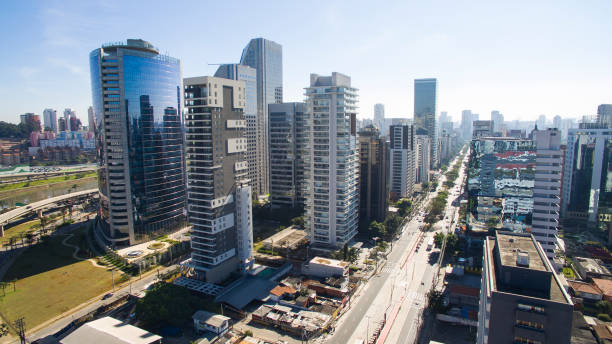
How To Describe A City In Writing (21 Important Steps)
Describing a city in writing is a profound act of literary alchemy, where words become the brushes and the canvas upon which the urban landscape is painted.
It is a journey through the senses, a symphony of sights, sounds, and emotions that invites readers to traverse the bustling streets and towering skyscrapers of a metropolis within the pages of a book.
As writers, we are not mere storytellers but architects of immersive worlds, tasked with the delicate mission of transforming the cityscape into a living, breathing character within our narratives.
In this exploration, we delve into the art of not just portraying the physicality of a city but of capturing its essence, personality, and the profound impact it exerts on the characters and stories that unfold within its embrace.
This guide will unravel the intricacies of describing a city in writing , offering insights into research, sensory imagery, symbolism, and the profound emotional resonance that can be achieved when the city itself becomes a vital protagonist in our tales.
Table of Contents
How To Describe A City In Writing
Describing a city in writing involves painting a vivid picture with words, capturing its essence, and conveying its unique character. Here’s a step-by-step process to help you do that effectively:
Choose Your City
Select the city you want to describe. It could be a place you’ve visited, lived in, or one that you’re researching.
Research and Observation
Gather information about the city’s history, culture, landmarks, and notable features. If possible, visit the city to observe its sights, sounds, and atmosphere firsthand.
Create an Outline
Before you start writing, make an outline to organize your thoughts. Consider what aspects of the city you want to highlight, such as its architecture, people, cuisine, or climate.
Engage the Senses
When describing the city, appeal to the reader’s senses. Describe what the city looks like, sounds like, smells like, tastes like, and feels like. This creates a more immersive experience.
Start with an Introduction
Begin your description with a captivating introduction that sets the scene and captures the reader’s attention. Mention the city’s name, location, and any notable facts.
Describe the Geography and Setting
Detail the city’s geographical location, including its surroundings – whether it’s nestled in the mountains, sprawled on the coast, or situated in a desert.
Architectural Features
Describe the city’s architecture, highlighting iconic buildings, bridges, or skyline. Explain their historical or cultural significance.
Cultural and Historical Context
Provide context by discussing the city’s history, its role in any historical events, and its cultural diversity. Mention any museums, monuments, or heritage sites.
Local Cuisine and Food Culture
Talk about the local cuisine and dining culture. Mention any famous dishes, street food, or culinary traditions that define the city.
Local Residents
Describe the people who call the city home. Talk about their lifestyles, customs, and the unique characteristics that make them distinct.
Climate and Weather
Discuss the city’s climate, seasons, and weather patterns. How do these factors affect daily life and the city’s atmosphere?
Green Spaces and Nature
If applicable, mention parks, gardens, and any natural elements within the city. Describe how these spaces contribute to the city’s ambiance.
Transportation and Infrastructure
Explain the city’s transportation systems, such as buses, subways, or iconic forms of transit. Also, note the quality of the roads and infrastructure.
Economic and Commercial Activities
Discuss the city’s economic activities, major industries, and commercial areas. Mention any famous shopping districts or markets.
Cultural Events and Entertainment
Highlight any cultural events, festivals, theaters, or entertainment venues that contribute to the city’s vibrancy.
Societal Atmosphere
Describe the general atmosphere and mood of the city. Is it bustling and fast-paced, laid-back, or somewhere in between?
Local Lingo and Slang
If there are unique words, phrases, or slang associated with the city, incorporate them to give your description authenticity.
Conclude with an Impression
Summarize your description with a final impression of the city. What makes it special, unique, or worth visiting?
Editing and Proofreading
Revise and edit your description for clarity, conciseness, and coherence. Ensure your writing flows smoothly.
Peer Review
If possible, have someone else read your description to get feedback and make improvements .
Final Touches
Add any final touches, such as descriptive metaphors, similes, or poetic language to make your writing more engaging.
Remember that the key to effective city description is to transport your reader to the city, allowing them to see, feel, and experience it through your words.

Pre-Writing Preparation
Pre-writing preparation is the compass that guides a writer through the uncharted territory of creativity. It’s the backstage pass to the grand spectacle of storytelling, a moment of quiet contemplation before the words burst onto the stage.
Like an architect surveying a blank canvas of land before sketching the blueprint of a majestic city, a writer delves into the city of their narrative.
Pre-writing is where facts marry imagination, and where intentions meet the canvas of possibilities.
It’s a symphony conductor fine-tuning their orchestra before the first note resonates through the concert hall.
In this sacred prelude to the literary journey, authors don the hats of historians, psychologists, and artists, sifting through the sands of time, human behavior, and creative expression to lay the foundation for a city that will exist solely on the pages of their story.
Research the city
Researching the city is akin to embarking on an exhilarating expedition through the annals of history and the vibrant tapestry of contemporary life.
It’s the literary archaeology that unearths the city’s secrets, laying bare its character, aspirations, and idiosyncrasies.
By delving into the rich chronicles of its past, we uncover the hidden gems of culture and tradition that have shaped the city’s essence.
This meticulous exploration brings to light the landmarks, the legends, the whispers of forgotten tales, and the bustling life that courses through its veins today.
It’s a treasure hunt for anecdotes, anecdotes that may be as old as the city itself or as fresh as the morning dew on a bustling market square.
Researching the city is the essential act of donning the shoes of an urban detective, ready to unearth the stories that will breathe life into the written metropolis.
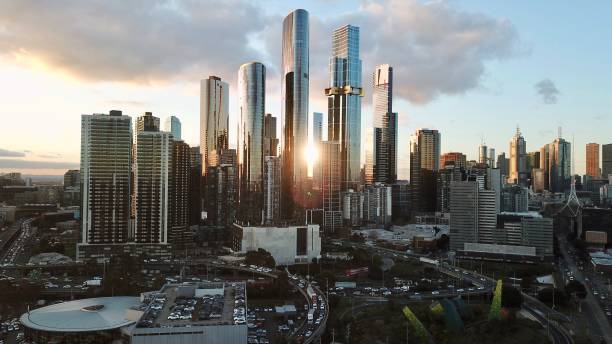
Determine the purpose of your description
Before the quill touches the parchment or the keyboard springs to life, there exists a pivotal juncture in the creative process: determining the purpose of your city’s description. It’s the compass that will set the direction for your narrative ship.
Are you seeking to merely set the stage, offering a vivid backdrop for your characters’ escapades, or is your aim to craft an atmosphere so immersive that it becomes a character in itself, an inseparable part of the story’s essence? Perhaps your purpose is to evoke emotions, to make your readers feel the pulse of the city as if it were their own heartbeat.
Identifying this purpose is akin to selecting the lens through which your readers will view the cityscape you’re painting.
It’s a conscious decision that shapes the tone, the depth, and the emotional resonance of your narrative, ensuring that each brick and cobblestone serves a purpose beyond mere aesthetics.
Sensory Imagery
Sensory imagery is the alchemical magic that transmutes words into sensations, transporting readers to worlds they’ve never physically traversed.
It’s the symphony of sight, sound, scent, touch, and taste meticulously woven into the fabric of storytelling.
With the stroke of a pen or the click of a keyboard, writers can paint vivid, three-dimensional cityscapes, enabling readers to not just see the towering spires, but to hear the whispers of history in the wind, smell the sizzle of street food, and feel the cobblestones beneath their fingertips.
Sensory imagery is the key that unlocks the secret door to a parallel universe, where words are not just symbols, but portals to experiences that transcend the page and ignite the imagination.
Personification
Personification is the literary sorcerer’s wand, the enchanting act of breathing life into the inanimate, a bewitching dance between imagination and language.
It transforms ordinary objects and abstract concepts into vibrant characters, imbued with human traits, emotions, and intentions.
It’s like giving the city a soul, an identity, a heartbeat that resonates with the reader’s own.
The bustling streets become animated veins, the skyscrapers become sentient giants, and the city itself, a living, breathing entity with its own stories to tell.
Through personification, the city doesn’t just exist as a backdrop; it becomes a vital player in the grand theater of the narrative, revealing its own secrets and desires, making it a character as intricate and unforgettable as any human protagonist.
Breathing life into the city
Breathing life into the city is the novelist’s act of rendering urban landscapes with the same intricate care as sculpting characters.
It’s a masterful stroke of the pen that infuses the concrete and steel with pulse and personality.
As a writer, you become an urban alchemist, conjuring a metropolis teeming with life, its streets a symphony of voices, its architecture a silent testimony to the aspirations and dreams of generations.
Through vivid descriptions and narrative insights, the city takes on a heartbeat of its own, influencing the emotions and decisions of the characters that dwell within its embrace.
It becomes a silent, omnipresent character, both nurturing and challenging, shaping the story’s very fabric.
Breathing life into the city is more than description; it’s the gift of a dynamic, breathing entity, a vibrant soul entwined with the tale you’re weaving, ensuring it resonates with readers long after the last page is turned.

Describing the city as if it were a character
Describing the city as if it were a character is a literary feat that invites readers to forge a personal connection with the urban landscape.
By endowing the city with human attributes, quirks, and emotions, it becomes more than a backdrop; it transforms into a dynamic entity that engages and resonates on an emotional level.
The city’s streets pulse with energy, its architecture carries the weight of history, and its mood shifts like the temperament of a well-drawn character.
Just like a person, the city can be enigmatic, nurturing, mysterious, or obstinate. It possesses a story, an identity, and, at times, a silent conversation with the story’s protagonists.
Describing the city in this way offers a unique lens through which readers can engage with the narrative, allowing them to feel the city’s heartbeat alongside the characters, making it a compelling and multidimensional presence within the story.
How the city interacts with its inhabitants
The intricate dance between a city and its inhabitants is a dynamic narrative of relationships, influence, and reciprocity. A city is not a passive stage but an active player in the lives of those who dwell within its bounds.
It weaves an intricate tapestry of encounters, juxtaposing moments of connection and disconnection, solitude and camaraderie.
It can be a demanding lover, challenging its residents to adapt and evolve, or a steadfast friend, providing a backdrop to their daily adventures.
The city’s streets and architecture absorb the stories and emotions of its people, silently witnessing their triumphs and tribulations.
Just as the city leaves its indelible mark on its inhabitants, the people, in turn, shape the city’s character through their actions and narratives.
This symbiotic relationship between city and inhabitant is a rich source of storytelling, a reflection of the ever-evolving, intricate connection that defines the human experience in urban landscapes.
Historical and Cultural Context
Historical and cultural context is the magical time machine that transports readers to bygone eras, illuminating the present with the shimmering torch of the past.
It’s a grand tapestry woven with the threads of events, beliefs, and traditions, a tapestry that unfurls before the reader, connecting the dots of history and culture in a mesmerizing narrative.
Through it, we unearth the buried treasures of forgotten dynasties, witness the rebellious spirit of revolutions, and partake in the timeless rituals of diverse societies.
It’s the secret code that unlocks the city’s deeper layers, revealing the whispers of the past in every cobblestone and skyline, and the vibrant traditions that breathe life into its streets today.
Historical and cultural context is the literary passport that guides us through the city’s ever-evolving story, making the past a vivid companion to the present, and infusing the narrative with a profound sense of time and place.
Character Reflection
Character reflection is the author’s mirror, the poignant moment when characters gaze into their own souls and reveal the intricate tapestry of their thoughts, desires, and vulnerabilities.
It’s a literary confession, the exposed nerve that makes characters not only relatable but irresistibly human.
Just as we ponder our own reflections in a mirror, characters delve into the depths of their experiences, confronting their fears, ambitions, and the truths they dare not speak.
In this intimate journey of self-discovery, characters may find enlightenment or become entangled in the labyrinth of their own complexities.
It is in these reflections that readers discover the beating hearts behind the words, forging connections that bridge the realms of fiction and reality.
Character reflection is the art of capturing the essence of the human spirit, inviting readers to not only observe but participate in the beautiful, tumultuous, and profound voyage of self-exploration.
Describing how the city affects characters’ emotions
The city, like a skilled conductor, orchestrates a symphony of emotions within its inhabitants. It can be an emotional tempest, where the ceaseless urban cacophony elicits anxiety and restlessness, or a soothing lullaby, offering solace amidst the bustling chaos.
The city’s changing moods can sweep characters into moments of exhilaration as they scale skyscrapers or plunge them into melancholy as they wander through abandoned alleyways.
It infuses their souls with a unique rhythm, mirroring their own emotional crescendos and decrescendos. Characters may find inspiration in its vibrant street art or harbor nostalgia beneath its time-worn lampposts.
The city is a silent confidant, echoing the joys, sorrows, and introspective contemplations of those who traverse its winding streets.
As a writer, exploring how the city affects characters’ emotions is akin to weaving an intricate dance between setting and psyche, unveiling the profound symbiosis between the urban landscape and the human heart.

Influences on the characters’ personalities and actions
The city, a living, breathing entity, serves as an invisible hand shaping the clay of its inhabitants’ personalities and actions. Its bustling streets, architectural marvels, and vibrant neighborhoods are like an intricate mosaic that influences character development.
The city can breed ambition, instilling a fierce determination in its residents as they navigate its competitive landscapes. Simultaneously, it can nurture a sense of community, prompting individuals to extend kindness and camaraderie to their neighbors.
The very rhythm of life in the city can turn people into fast-paced, quick-thinking go-getters or patient, adaptable souls who’ve mastered the art of survival.
It can provoke rebellion or inspire innovation, fostering traits like resilience, resourcefulness, and adaptability.
The city’s stories, both whispered and shouted, often become the tales that shape a character’s values and ambitions.
In this dynamic, reciprocal relationship, the city becomes a character itself, intricately intertwined with the very essence of those who reside within its bounds.
Metaphors and Symbols
Metaphors and symbols are the elusive keys that unlock the treasure chest of meaning in writing, turning words into a labyrinth of hidden gems waiting to be discovered.
Like whispered secrets in a crowded room, metaphors invite readers to see beyond the literal, to peel away the layers of reality, and dive into the depths of imagination.
Symbols, on the other hand, are the archetypal lighthouses that guide readers through the darkest narrative storms, offering profound insight into universal truths.
Together, they transform the mundane into the magical, the tangible into the ethereal. In the hands of a skillful writer, metaphors and symbols become the alchemical catalysts that transmute words into feelings, connecting the author’s vision with the reader’s heart.
They are the literary constellations that adorn the writer’s night sky, each dot of brilliance igniting a universe of interpretation, ensuring that every word is more than it seems, concealing worlds within worlds, inviting readers to lose themselves in the infinite labyrinth of storytelling.
Symbols that represent the essence of the city
Symbols, like hidden gems scattered throughout a treasure trove, represent the very essence of the city, encapsulating its identity, history, and collective spirit. Each symbol is a sentinel, standing as a silent witness to the city’s past and its evolving present.
These iconic emblems embody the aspirations and stories of its people, resonating like a timeless melody.
Whether it’s an architectural marvel, a revered monument, or a simple street corner cafe, these symbols become the threads that weave together the city’s unique narrative, serving as a tapestry of memory and significance.
They are more than just objects; they are living metaphors that reflect the city’s soul, serving as touchstones for the emotions and experiences that define life within its bounds.
As writers, these symbols offer us a powerful means to convey the city’s depth, invoking a collective consciousness that binds readers and characters to the heartbeat of the urban landscape.
Narrative Perspective
Narrative perspective is the kaleidoscope through which stories unfold, a prism that shapes the colors and contours of our literary worlds.
It’s the writer’s ultimate sleight of hand, the magic that lets us slip into the shoes of characters, hover like an invisible observer, or wield god-like knowledge over the tale.
First-person perspective invites readers to delve deep into a character’s psyche, becoming an intimate confidant to their thoughts and feelings.
Third-person offers an all-seeing eye, revealing a broader tapestry of events and emotions, while omniscient perspective allows us to traverse time and space, connecting the dots of the narrative’s universe.
Narrative perspective isn’t just a technical choice; it’s a transcendental experience, a shifting of dimensions that immerses us in a story’s soul.
Writers play the role of cosmic architects, selecting the lens through which readers perceive their imaginative worlds, making narrative perspective the gateway to limitless storytelling possibilities.

Progressive Description
Progressive description is the art of storytelling akin to an unfolding flower, revealing its petals one by one. It’s the literary equivalent of a treasure hunt, a tantalizing journey that entices readers to follow the breadcrumb trail of details, layer by layer.
This technique isn’t just about depicting a static cityscape but rather about crafting a dynamic, evolving narrative where every detail unfurls at the perfect moment, much like a seasoned magician revealing tricks in a carefully choreographed show.
It keeps the reader on their toes, inviting them to savor each revelation and fostering a sense of wonder and anticipation.
Progressive description is the storyteller’s symphony, building to a crescendo, leaving readers in rapturous suspense until the final notes of the narrative resound in their imagination, making it a literary technique that turns mere words into a captivating journey of discovery.
Building the city’s image progressively
Building the city’s image progressively is akin to a masterful brushstroke that gradually unveils the vivid portrait of an urban landscape.
It’s a process of strategic revelation, designed to engage readers’ senses and curiosity step by step, much like a captivating mystery slowly unraveling its secrets.
As the narrative unfolds, the city’s details emerge organically, creating a gradual immersion that mirrors real-life exploration.
This technique allows readers to forge a deeper connection with the setting, as if they are uncovering the city’s character, one layer at a time.
It kindles anticipation and fosters a sense of attachment to the story’s backdrop, making the city not just a static canvas but a living entity that breathes alongside the characters.
In the hands of a skillful writer, building the city’s image progressively transforms the setting into a dynamic, integral part of the narrative, ensuring that it resonates in the reader’s imagination long after the final page is turned.
Emotional Resonance
Emotional resonance in storytelling is the echo that lingers in a reader’s heart long after the book is closed. It’s the indelible mark left by words that can make us laugh, cry, or ponder life’s enigmas.
Like an ethereal connection between the author and the reader, emotional resonance transcends the pages, making characters and their journeys feel vividly real.
It’s that unspoken understanding, the feeling that the author has bared their soul on the page, and we, as readers, have been seen and understood in return.
Whether it’s the poignancy of a character’s triumph, the bittersweet farewell, or the deep well of empathy for their struggles, emotional resonance is the essence of storytelling’s magic, leaving us irrevocably changed, as if we’ve not just read a book, but lived it.
Frequently Asked Questions (FAQ) about How To Describe A City In Writing
What is the purpose of describing a city in writing.
Describing a city in writing serves various purposes, such as creating a vivid mental image, promoting tourism, conveying the city’s unique character, or capturing the essence of a place for literature or travel guides.
Do I need to visit the city to describe it effectively?
While firsthand experience is beneficial, it’s not always necessary. You can conduct research, gather information, and use your imagination to describe a city effectively.
What aspects of a city should I focus on when describing it?
Focus on various aspects, including the city’s geography, architecture, culture, history, people, cuisine, climate, and local attractions.
How can I make my city description more engaging to readers?
Engage readers by using descriptive language, appealing to their senses (sight, sound, smell, taste, touch), and sharing personal anecdotes or stories related to the city.
How do I balance facts and creativity when describing a city?
Balancing facts and creativity is essential. Use facts to provide context and accuracy, and then weave in creative language and storytelling to make the description engaging.
Are there any common mistakes to avoid when describing a city in writing?
Avoid clichés, overusing adjectives, being overly biased, and neglecting to edit and proofread your work. Also, be sensitive to cultural nuances and avoid stereotypes.
What is the ideal length for a city description?
There’s no fixed length, but it should be long enough to capture the city’s essence without becoming overly verbose. It can range from a few paragraphs to several pages, depending on your purpose.
Can I include personal opinions and emotions in a city description?
Yes, sharing your personal opinions and emotions can add authenticity to your description, as long as you balance them with factual information.
How can I make my city description stand out from others?
Make your description unique by highlighting less-known aspects of the city, using vivid language, and adding a personal touch or perspective that sets it apart from typical descriptions.
Can I use online resources or travel guides for information when describing a city?
Absolutely, online resources, travel guides, and books about the city are valuable sources of information to enhance the accuracy and depth of your description. Just be sure to credit your sources when necessary.
In the tapestry of storytelling, the city stands as a vibrant thread, woven intricately into the fabric of our narratives.
Describing a city in writing is more than a creative task; it’s an invitation for readers to embark on journeys of exploration and emotion, guided by our words and immersed in the sensory world we’ve constructed.
As we conclude this guide on how to describe a city in writing , we must remember that cities are not static backdrops but dynamic, breathing entities that influence the characters and narratives within them.
Through careful research, evocative sensory imagery, personification, and rich symbolism, we can paint cityscapes that resonate deeply with readers, fostering an emotional connection that extends far beyond the confines of the page.
The city, with its towering spires and bustling streets, becomes not just a setting but a living, breathing character, an integral part of our stories.
So, let us continue to craft cities that speak to the soul, forging narratives that transport readers to distant urban landscapes, allowing them to lose themselves in the intoxicating hum of the metropolis and, in doing so, to discover the magic of storytelling in its fullest form.
Related Posts:
- How To Describe Running In Writing (10 Best Ways)
- Christmas story ideas Tips And Prompts
- How To Describe Buildings In Writing (20 Important…
- How To Describe A Village In Writing (10 Creative…
How To Write A Scene With Multiple Locations (12 Best Tips)
Similar posts.

How To Write Simultaneous Scenes (13 Best Ways)
In the world of storytelling, there exists a powerful technique that allows writers to breathe life into their narratives like never before. It’s a narrative tightrope walk, a dynamic dance of words, and a captivating literary feat that can mesmerize readers and elevate a story to new heights. We are talking about “Simultaneous Scenes,” a…

How To Get Unstuck When Writing A Play (15 Best Tips)
Embarking on the journey of playwriting can be an exhilarating yet occasionally tumultuous adventure, where the creative mind may find itself entangled in the web of uncertainty and stagnation. The art of writing a play, with its multifaceted characters, intricate plots, and the delicate dance of dialogue, can sometimes present challenges that leave even the…

How To Describe Hands In Writing (10 Important Steps)
In the intricate dance of storytelling, hands emerge as silent narrators, weaving tales through the subtle nuances of their movements, textures, and expressions. Crafting evocative descriptions of hands in writing is an art that transcends the mundane, inviting readers to touch the very soul of characters and narratives. As writers, the ability to depict hands…

Embarking on the art of crafting scenes with multiple locations is akin to wielding a literary compass that navigates the vast terrain of storytelling. In the realm of narrative tapestry, the ability to seamlessly transition characters across diverse settings is an essential skill that elevates a story from the mundane to the extraordinary. Each locale…

How To Describe Betrayal In Writing (15 Important Steps)
Describing betrayal in writing is an art that goes beyond mere storytelling; it’s a journey into the depths of human emotions and the intricate labyrinth of trust and deceit. Betrayal is a universal theme that resonates with readers because it reflects the complexities of human relationships, motives, and the profound impact of broken trust. In…

How To Write A Character Driven Story (15 Best Tips)
Embarking on the journey of crafting a character-driven story is akin to venturing into the heart of storytelling itself. In these narrative realms, characters cease to be mere ink on the page; they metamorphose into living, breathing entities that propel the story forward with their desires, conflicts, and transformative arcs. This artful approach places characters…

Guide to Describing a City in Writing

Affiliate Disclaimer
As an affiliate, we may earn a commission from qualifying purchases. We get commissions for purchases made through links on this website from Amazon and other third parties.
Describing a city in writing can be a daunting task, especially for those who don’t have much experience with it. However, with the right guidance and examples, anyone can master this skill.
That’s why this article aims to provide a comprehensive guide to describing a city in writing, with over 100 brilliant examples to inspire and guide writers.
Whether you’re a travel writer, a novelist, or simply someone who wants to capture the essence of a city in their writing, this guide has something for everyone. From the bustling streets of New York City to the winding canals of Venice, each example offers a unique perspective on how to describe a city in writing.
With this guide, writers will learn how to use sensory details, figurative language, and descriptive adjectives to bring a city to life on the page. They’ll also learn how to capture the mood and atmosphere of a city, whether it’s the energy of a vibrant metropolis or the tranquility of a sleepy town.
So whether you’re writing a novel set in a specific city or simply want to capture the essence of a place in your travel writing, this guide is the perfect resource to help you do just that.
Fundamentals of Urban Description
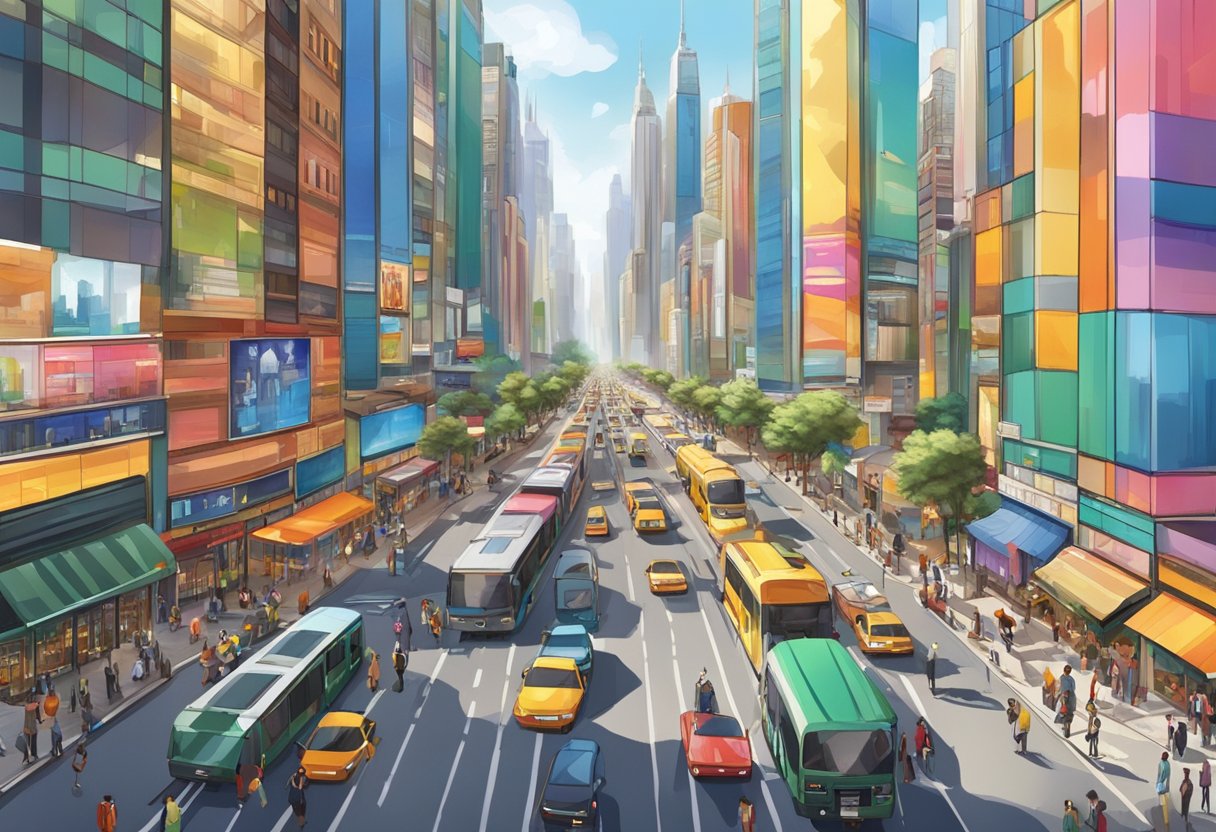
When it comes to describing a city in writing, there are certain fundamentals that must be understood in order to paint a vivid picture for the reader. In this section, we will cover the two key aspects of urban description: understanding cityscapes and using descriptive language and vocabulary.
Understanding Cityscapes
Before attempting to describe a city, it is important to understand the different elements that make up its landscape. This includes the architecture, infrastructure, landmarks, and natural features such as parks and rivers. By having a clear understanding of these elements, the writer can create a more accurate and detailed description.
When describing a cityscape, it is also important to consider the perspective of the writer. Are they viewing the city from above, from a distance, or up close? This will affect the level of detail and the language used in the description.
Descriptive Language and Vocabulary
One of the most important aspects of urban description is the use of descriptive language and vocabulary. This includes adjectives, adverbs, and verbs that are used to convey the sights, sounds, and atmosphere of the city.
When selecting adjectives to describe a city, it is important to choose words that accurately reflect its character. For example, a bustling city might be described as vibrant, while a more serene city might be described as peaceful.
Grammar and pronunciation are also important considerations when describing a city. By using proper grammar and enunciating words clearly, the writer can create a more polished and professional description.
Overall, understanding the fundamentals of urban description is essential for creating a compelling and accurate portrayal of a city in writing. By using descriptive language and vocabulary, and considering the different elements of the cityscape, the writer can transport the reader to the heart of the city and bring it to life on the page.
City Size and Structure
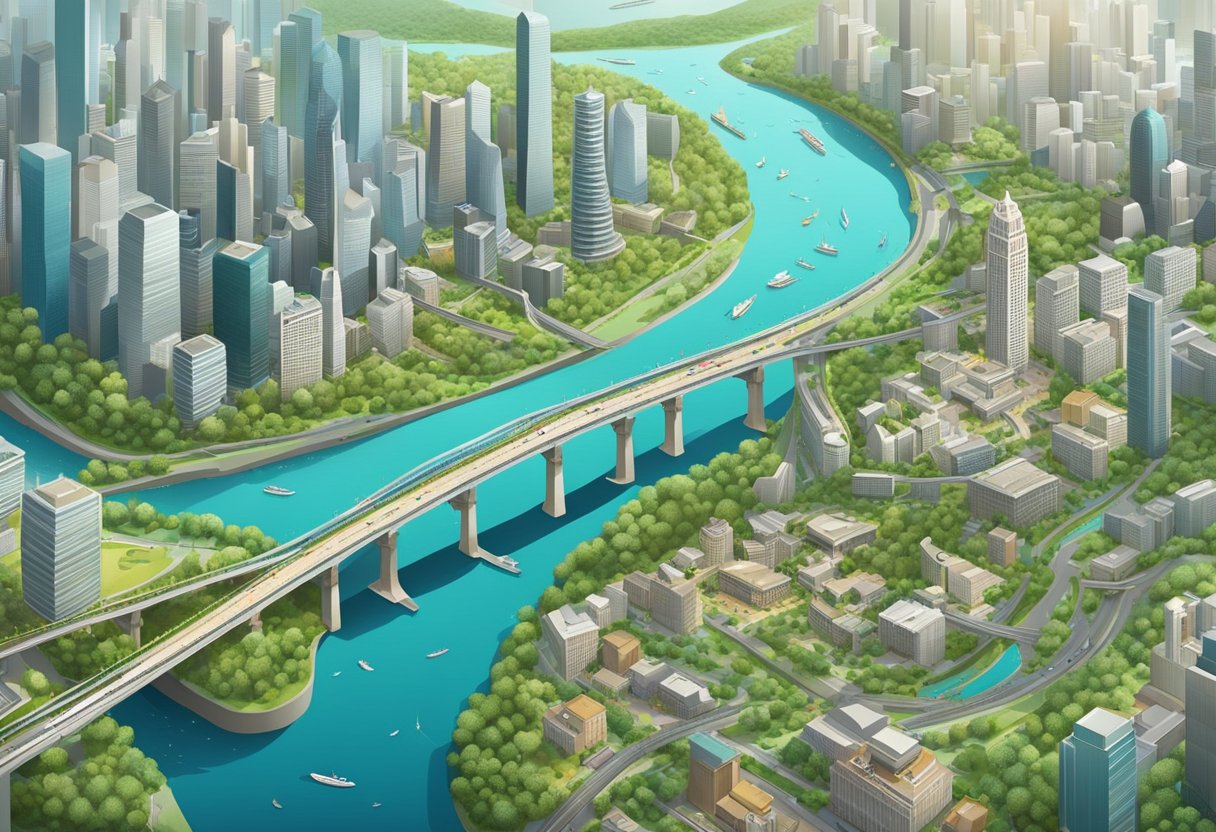
From Sprawling Metropolises to Compact Towns
Describing a city’s size and structure is an essential aspect of capturing its essence in writing . Cities come in all shapes and sizes, from sprawling metropolises to compact towns. The size of a city can significantly impact its character, culture, and lifestyle. Larger cities often have more diverse populations, a wider range of cultural activities, and more significant economic opportunities. Smaller cities, on the other hand, tend to have a more intimate feel, with a stronger sense of community and a slower pace of life.
When describing a city’s size, it is essential to consider not only its population but also its physical boundaries. A city’s limits can be defined by natural features such as rivers or mountains or by man-made borders such as highways or city limits signs. The physical boundaries of a city can significantly impact its structure and layout, with cities often developing in distinct neighborhoods or districts.
The Role of Streets and Public Transport
The streets and public transport systems of a city are also critical components of its structure and character. The layout of a city’s streets can impact its accessibility, walkability, and overall aesthetic. For example, a city with a grid-like street pattern may feel more organized and straightforward to navigate than one with winding, narrow streets.
Public transport is also a crucial aspect of a city’s structure, providing residents and visitors with a means of getting around. A well-developed public transport system can make a city more accessible and reduce traffic congestion. In contrast, a poorly designed system can make it challenging to get around and limit economic opportunities.
Overall, when describing a city’s size and structure, it is essential to consider its physical boundaries, street layout, and public transport systems. These factors can significantly impact a city’s character and lifestyle, making them essential components of any city description.
The Essence of Time and Age
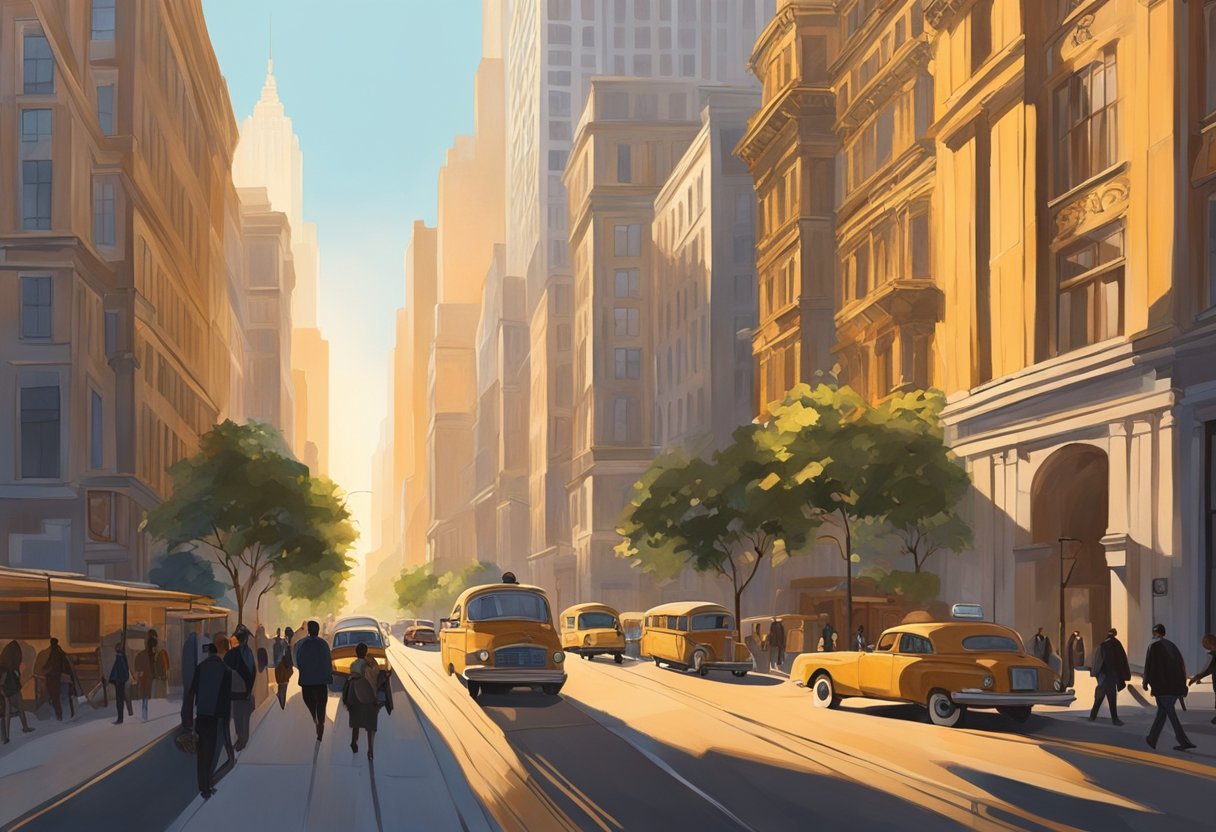
Cities are dynamic entities that are constantly changing and evolving. One of the most significant aspects of a city’s character is its history and how it has developed over time. Understanding the essence of time and age is essential when describing a city in writing .
Historical vs. Modern Developments
Cities are often a blend of historical and modern developments. The historical parts of the city are often the most visually striking, with ancient architecture, narrow streets, and traditional markets. In contrast, modern developments are characterized by glass skyscrapers, wide boulevards, and modern amenities.
When describing a city, it is essential to highlight both the historical and modern aspects of the city. A balance between the two is vital in creating a vivid and accurate picture of the city’s character.
The Impact of Time on City Life
Time has a profound impact on city life. As cities grow and evolve, their character changes. Old neighborhoods are replaced by new developments, and the city’s infrastructure is updated to keep pace with modern needs.
The impact of time on city life can be seen in everything from the city’s architecture to its culture. Old buildings may be preserved as historical landmarks, while new buildings may be designed to reflect the latest architectural trends. Similarly, the city’s culture may be influenced by its history, or it may be shaped by modern trends.
In summary, the essence of time and age is a critical aspect of describing a city in writing. By highlighting the historical and modern developments of a city and the impact of time on city life, writers can create an accurate and vivid picture of the city’s character.
Socioeconomic Diversity

Wealth and Poverty in Urban Settings
One of the most striking aspects of any city is its socioeconomic diversity. Urban areas are often characterized by a stark contrast between the affluent and the poor. While some neighborhoods boast luxury apartments and high-end boutiques, others are home to run-down buildings and deprived communities.
Population density is a major factor in determining the level of wealth or poverty in a city. In densely populated areas, property prices can skyrocket, making it difficult for low-income families to afford housing. This often leads to residential segregation, with affluent neighborhoods located in the suburbs and poorer communities concentrated in the city center.
Residential Variations
Residential variations are another important aspect of socioeconomic diversity in cities. Suburban areas are often associated with larger, single-family homes, while urban areas are more likely to have high-rise apartments and condominiums. However, there are exceptions to these generalizations.
In some cities, there has been a recent trend towards mixed-use developments, which combine residential and commercial spaces in the same building. This can create a more diverse and vibrant community, as people from different socioeconomic backgrounds are brought together in the same space.
Overall, understanding the socioeconomic diversity of a city is crucial for anyone looking to describe it in writing. By paying attention to factors such as population density, property prices, and residential variations, writers can create a more accurate and nuanced portrayal of the urban landscape.
Cultural and Architectural Tapestry

Cultural Landmarks and Events
A city’s cultural landmarks and events are a reflection of its past and present. From traditional festivals to contemporary art exhibitions, a vibrant cultural scene can be a defining feature of a city. Visitors to a city can immerse themselves in its culture by attending events or visiting landmarks that showcase its heritage.
For instance, the colonial city of Cartagena in Colombia is known for its colorful festivals, such as the Cartagena International Music Festival and the Hay Festival. These events celebrate the city’s rich cultural heritage and attract visitors from around the world.
In contrast, the cosmopolitan city of New York is home to iconic cultural landmarks such as the Metropolitan Museum of Art and the Lincoln Center for the Performing Arts. These institutions showcase a diverse range of art and performances that reflect the city’s contemporary and global outlook.
Architectural Styles and Significance
A city’s architecture is a visual representation of its history and identity. From colonial buildings to Bauhaus-inspired designs, a city’s architectural styles can convey its cultural and social values.
For example, the traditional architecture of Kyoto in Japan reflects the city’s deep connection to its past. The city’s temples and shrines, such as the Kiyomizu-dera and the Fushimi Inari-taisha, are renowned for their intricate designs and historical significance.
On the other hand, the contemporary architecture of Dubai in the United Arab Emirates showcases the city’s ambition and innovation. The Burj Khalifa, the world’s tallest building, and the Dubai Mall, the world’s largest shopping center, are examples of the city’s modern architectural achievements.
In conclusion, a city’s cultural and architectural tapestry can reveal its unique character and identity. By exploring a city’s cultural landmarks and architectural styles, visitors can gain a deeper understanding of its history and values.
Environmental Aspects
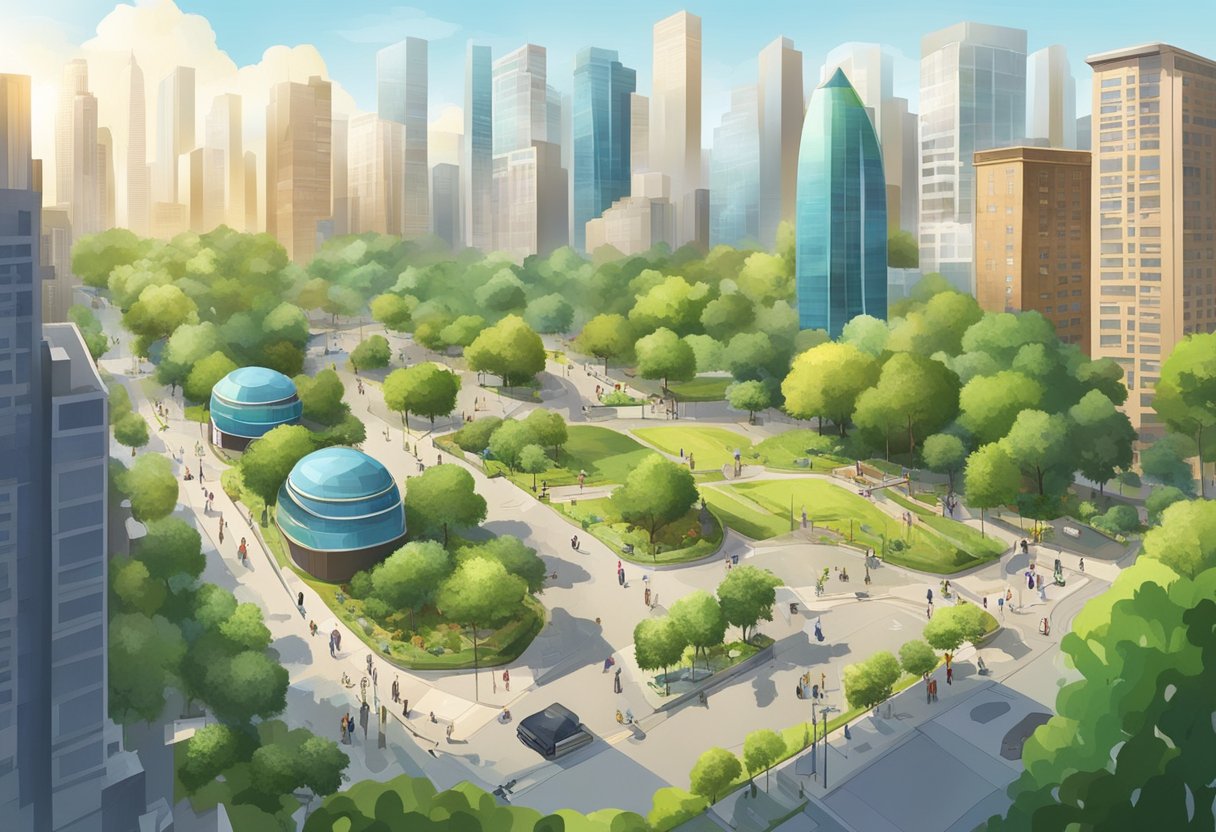
Geographical Settings
When describing a city’s environmental aspects, it is important to consider its geographical location and settings. Some cities are situated on the coast, while others are nestled in the mountains or surrounded by vast plains. These geographical features can greatly impact the climate, weather patterns, and overall environmental conditions of the city.
For instance, a city located on the coast may experience more humid conditions due to the ocean’s proximity. On the other hand, a city situated in the mountains may have cooler temperatures and experience more precipitation. It is important to consider these geographical settings when describing a city’s environmental aspects.
Climate and Weather Patterns
The climate and weather patterns of a city are also important factors to consider when describing its environmental aspects. Some cities may have a tropical climate with high temperatures and heavy rainfall, while others may have a more temperate climate with mild temperatures and moderate rainfall.
It is also important to consider the seasonal weather patterns of a city. Some cities may have distinct seasons with significant temperature changes and varying amounts of precipitation. Others may have more consistent weather patterns throughout the year.
Overall, when describing a city’s environmental aspects, it is important to consider its geographical settings, climate, and weather patterns. By providing detailed information about these factors, readers can gain a better understanding of the city’s overall environmental conditions.
The Living City

Describing the living city involves capturing the essence of daily life, economy, nightlife, and entertainment in a way that is informative and engaging. Here are a few examples of how to describe a city in writing .
Daily Life and Economy
A city’s economy is a reflection of its people, and this is evident in the daily life of its residents. In a bustling city, people are constantly on the move, with a sense of purpose and urgency in their step. The economy is vibrant, with a diverse range of industries contributing to the city’s growth. From finance to technology, the city is a hub of innovation and entrepreneurship.
The people of the city are diverse, with a mix of ages, cultures, and backgrounds. The city is home to young professionals, families, and retirees, all of whom contribute to the city’s unique character. The streets are alive with the sounds of different languages and accents, creating a sense of vibrancy and energy.
Nightlife and Entertainment
When the sun sets, the city comes alive with a different kind of energy. The nightlife is exciting and varied, with something for everyone. From trendy bars to underground clubs, the city’s nightlife scene is as diverse as its people. The city is also home to a thriving arts and culture scene, with museums, galleries, and theaters showcasing the best of local and international talent.
Despite the excitement of the city’s nightlife, there are also quieter corners to be found. The city’s parks and green spaces provide a peaceful retreat from the hustle and bustle of city life. Whether it’s a morning jog or an afternoon picnic, the city’s parks offer a welcome respite from the noise and chaos of the city.
In conclusion, describing a city in writing requires a keen eye for detail and an understanding of the city’s unique character. By capturing the essence of daily life, economy, nightlife, and entertainment, a writer can paint a vivid picture of what makes a city truly special.
Sensory Experiences and Atmosphere
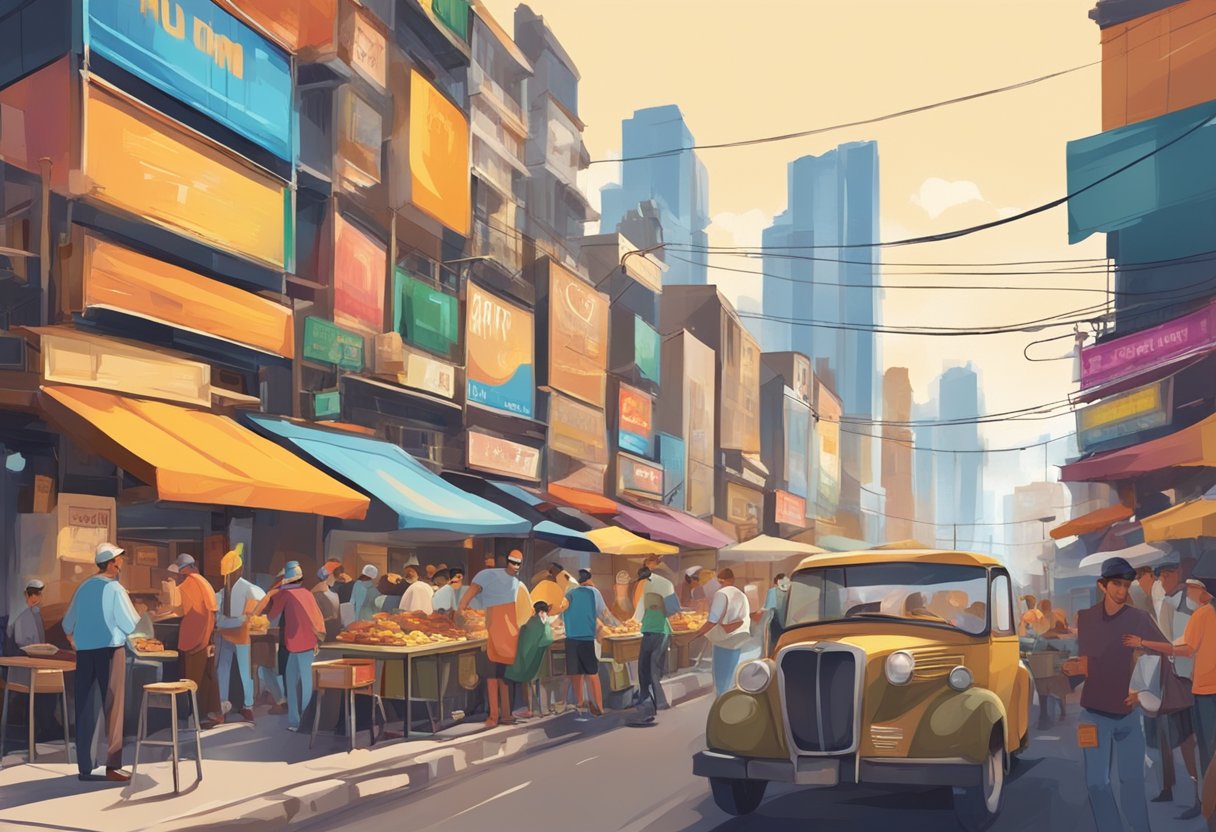
Visual Descriptions
When describing a city, it is essential to paint a vivid picture of what the reader can expect to see. The visual descriptions should be clear and concise, highlighting the unique features of the city. A wide and bustling city will have a lot of movement and activity, while a clean and vast city will have more open spaces.
Skyscrapers are an iconic feature of many cities, and they can be described in great detail. The height, shape, and design of the buildings should be noted, as well as any unique features such as rooftop gardens or observation decks.

Soundscapes and Olfactory Details
The sounds and smells of a city are just as important as the visual descriptions. A crowded and polluted city may have a distinct smell of exhaust fumes and filth, while a clean and bustling city may have a pleasant aroma of street food and fresh flowers.
The soundscapes of a city can also be described in detail. The noise of traffic, people talking, and street performers can add to the atmosphere of a city. On the other hand, a quiet city with little noise can be just as appealing to some visitors.
Overall, when describing a city’s sensory experiences and atmosphere, it is important to be clear and concise while also conveying the unique features of the city. Using descriptive language and formatting such as tables and lists can help the reader visualize the city and understand its atmosphere.
Character and Mood

Personifying the Urban Environment
Cities have their own character, and one way to describe them is by personifying them. For example, a city may be described as having a “gritty” personality, with its rough edges and tough exterior. Alternatively, a city may be described as “sleek” or “polished,” with a modern and sophisticated vibe.
Personifying a city can also help to convey its mood. A city with a bustling, energetic vibe may be described as having a “feverish” personality, while a city that is more laid-back and relaxed may be described as “mellow” or “easy-going.”
Emotive Descriptions
Describing a city’s character and mood can also be done through emotive descriptions. Using vivid language to describe the sights, sounds, and smells of a city can help to convey its overall mood and atmosphere.
For example, a city with a bustling downtown area may be described as “vibrant” and “energetic,” with the sounds of honking horns and bustling crowds filling the air. On the other hand, a quieter, more residential area may be described as “peaceful” and “serene,” with the sound of rustling leaves and chirping birds.
Overall, describing a city’s character and mood is an important part of capturing its essence in writing. By personifying the urban environment and using emotive descriptions, writers can paint a vivid picture of the city for their readers.
Practical Examples and Exercises
Crafting descriptive paragraphs.
Crafting descriptive paragraphs is an essential skill for any writer seeking to describe a city in writing. To help writers develop this skill, the Guide to Describing a City in Writing: Over 100 Brilliant Examples offers practical examples and exercises.
One effective exercise involves selecting a setting within the city and describing it in detail. For example, a writer might choose a bustling city street and describe the sights, sounds, and smells that surround them. This exercise helps writers develop their ability to observe and describe the world around them.
Another exercise involves selecting an object commonly found in the city and describing it in detail. For example, a writer might choose a street vendor’s cart and describe the colors, textures, and smells associated with it. This exercise helps writers develop their ability to focus on specific details and create vivid imagery.
Analyzing Exemplary Texts
Analyzing exemplary texts is another effective way to develop descriptive writing skills. The Guide to Describing a City in Writing: Over 100 Brilliant Examples provides readers with a wide range of exemplary texts that showcase effective descriptive writing.
For example, one exemplary text featured in the guide is an article from a popular travel magazine that describes the city’s historic district. The article uses vivid language and sensory details to transport readers to the heart of the city’s rich history.
Another exemplary text featured in the guide is a memoir that describes the author’s experiences growing up in the city. The memoir uses personal anecdotes and vivid descriptions to bring the city to life and convey a sense of nostalgia for the author’s childhood home.
By analyzing these exemplary texts, writers can gain a better understanding of the techniques and strategies used to create effective descriptive writing. They can then apply these techniques to their own writing and develop their own unique voice and style.
Latest posts

Achieving Your Word Count Goals with Daily Sprints: A Guide
Many writers struggle with meeting their word count goals, whether it’s for a school assignment, a blog post, or a novel. It can be frustrating to stare at a blank page or screen and feel like you’re not making progress. However, there is a technique that can help you achieve your word count goals and…

Beat Burnout: Setting Reasonable Writing Expectations
Writing can be a fulfilling and rewarding experience, but it can also be exhausting and draining. Writing burnout is a real phenomenon that can affect anyone, from professional writers to students. When writers push themselves too hard, they can experience stress, lack of motivation, and even physical symptoms like headaches and fatigue. To avoid burnout,…

Dealing with Criticism and Rejection as an Author: Tips and Strategies
As an author, receiving criticism and rejection is an inevitable part of the writing process. It can be difficult to navigate the emotions that come with having your work scrutinized, but it’s important to remember that criticism and rejection are not personal attacks. Instead, they are opportunities for growth and improvement. One way to deal…
Descriptive Essay
Descriptive Essay About A Place
Writing a Descriptive Essay About A Place - Guide With Examples
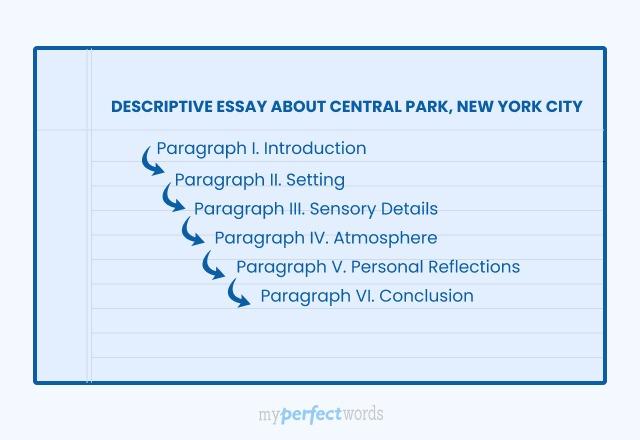
People also read
Descriptive Essay - A Complete Guide
Descriptive Essay Examples & Writing Tips
Top 250+ Descriptive Essay Topics & Ideas
Creating a Descriptive Essay Outline - Format & Example
Crafting an Authentic Portrait: A Guide to Writing a Descriptive Essay About a Person
Writing a Descriptive Essay About Myself - Tips and Tricks
How to Craft the Perfect Descriptive Essay About A Person You Admire
Descriptive Essay About My Mother - A Guide to Writing
Delicious Descriptions: A Guide to Writing a Descriptive Essay About Food
Write A Descriptive Essay About Nature With This Guide
Learn Tips to Write a Descriptive Essay About Autumn - Step into the Golden Season
Are you writing an essay about a place and need to know where to start?
The beauty of the world lies in its diversity, and every place has something unique to offer. A descriptive essay can bring these places alive for readers. But the question is, how do you write one?
Don't worry! We've got the right answer for you!
With a few examples and some tips on crafting your own essay, you can write it easily.
So read on to find good samples and tips to follow!
- 1. Understanding Descriptive Essays
- 2. Examples of Descriptive Essay About Any Place
- 3. Tips for Writing an Excellent Descriptive Essay About A Place
Understanding Descriptive Essays
A descriptive essay is a type of writing that aims to describe and portray an object, person, or place. The essay typically includes sensory details to help the reader imagine its contents more vividly. Descriptive essays can be written about a person , place, or other themes like nature , autumn , food , or even yourself .
A descriptive essay about a place should provide enough details for the reader to build a mental image of it. To do this, you need to include vivid descriptions and relevant information that could paint a picture in their minds.
Let's read some examples to see what a good descriptive essay looks like.
Examples of Descriptive Essay About Any Place
Here are some descriptive writing about a place examples:
Example of a Descriptive Essay About a Place
Descriptive Essay About a Place You Visited
Descriptive Essay About a Place Called Home
Descriptive Essay About a Place You Loved as a Child
Descriptive Essay About a Place of Interest I Visited
Descriptive Essay About a Favorite Place
Do you need more sample essays? Check out more descriptive essay examples t o get inspired.
Tips for Writing an Excellent Descriptive Essay About A Place
Now that you've read some examples of descriptive essays about places, it's time to learn how to write one yourself. Here are some tips on writing a great essay:
Choose The Right Topic
The topic of your essay should be something that you have a strong connection to or feeling about. It could be a place you've visited recently or a place from your childhood. Moreover, make sure that it's something that you can write about in enough detail to make your essay interesting.
Check out this blog with 100+ descriptive essay topics to get your creative juices flowing.
Gather Information
Gather as much information as possible about the topic of your essay. This will help you craft vivid descriptions and portray an accurate picture for your readers. Gather your observations, research online, and talk to people who have visited the place you're writing about.
Make sure to research the topic thoroughly so you can provide accurate and detailed descriptions. Read up as much as you can about the history of the place, and any interesting facts or stories about it.
Structure Your Essay
Outline your descriptive essay before beginning to write so all points flow logically from one to another throughout the entire piece.
Make sure to include a strong introduction and conclusion, as well as several body paragraphs that help support your main points.
Include Sensory Details
Use sensory language by including details such as sights, smells, tastes, sounds, etc. This helps to engage readers and transport them into the setting of your essay.
When writing a descriptive essay, make sure to include vivid descriptions that involve all five senses. This will help create a more engaging and immersive experience for your readers.
Use Vivid Language
Make sure to use strong and powerful words when describing the place you're writing about. Use metaphors and similes to bring your descriptions to life and make them more interesting for readers.
Proofread Your Essay
Proofreading is an important step in any writing process, especially when it comes to descriptive essays. Make sure to check for any typos or spelling errors that may have slipped through in your writing.
You also need to make sure that the flow of your essay is logical and coherent. Check if you've used a consistent point of view throughout, and make sure that all ideas are well-supported with evidence.
Follow these tips and examples, and you'll be well on your way to writing a great descriptive essay.
Don't stress if you still want a professional writer to do it for you. We've got the best solution for you.
MyPerfectWords.com offers the best custom essay writing service to help you write a great descriptive essay. Our experienced writers are here to provide high-quality and error-free work to help you get the grade you deserve. With our essay writing service, you are guaranteed a 100% original essay.
Get in touch with us to hire our descriptive essay writing service now.

Write Essay Within 60 Seconds!

Caleb S. has been providing writing services for over five years and has a Masters degree from Oxford University. He is an expert in his craft and takes great pride in helping students achieve their academic goals. Caleb is a dedicated professional who always puts his clients first.

Paper Due? Why Suffer? That’s our Job!
Keep reading
-10240.jpg&w=828&q=75)
Essays About Cities: Top 7 Examples and 10 Prompts
If you’re writing an essay about cities, discover helpful examples of essays about cities and prompts in our guide to help stir your creative thoughts.
Cities are the most stable social organization that has stood the test of time. A place achieves city status not only because of the sheer size of its population but also because of its territories, economic development, and political influence. Creating sustainable and resilient cities has attracted significant attention from academics, policymakers, civic groups, and the private sector over the years. This interest is spurred by pressing threats to the livability of cities, such as flooding, pollution, urban migration, and congestion. Whether you live in a city or dream of city life, writing an essay on this topic is a fantastic way to convey your thoughts on this topic.
Check out below some amazing essay examples and prompts to help you create an insightful essay.
7 Best Essay Examples
1. cities are scrambling to prevent flooding by casey crownhart, 2. putrajaya: the capital city you’ve never heard of by ronan o’connell, 3. japan’s hidden jewels: the abandoned island of hashima by hannah bergin, 4. planning to preserve — keeping heritage relevant in cities by marcus ng, 5. building the city of the future — at a $41 trillion price tag by aneri pattani, 6. 8 highlights from enabling masterplan 2030 to empower persons with disabilities by shermaine ang and goh yan han, 7. how cities are using technology to solve their trash problems by nell lewis, 10 writing prompts for essays about cities, 1. all about your city, 2. anti-congestion policies in your city, 3. fixing flood-prone cities, 4. green cities, 5. city vs. countryside, 6. cities in the metaverse, 7. what are megacities, 8. criminality in cities, 9. bucket list cities, 10. agriculture in cities.
“In many cases, their existing systems are aging and built for the climate of the past. And even upgrades can do only so much to mitigate the intense flooding that’s becoming more common, leaving cities to come up with other solutions.”
In this article, Crownhart delves into how states across the United States are experiencing unprecedented flood levels that are drowning out entire towns. While a total upgrade is urgent, it is also insanely costly.
“Building Putrajaya from scratch also afforded generous opportunities for innovation. Mahathir’s goal was to make Putrajaya Malaysia’s most eco-friendly urban centre and its most modern.”
In this Essay, O’Connell describes some capital cities we may not know of. Focusing on Malaysia, we learn that Putrajaya aimed to serve as Malaysia’s next capital during the worsening congestion in Kuala Lumpur. Now, Malaysia’s administrative and judicial capital offers the lure and peace of a sleeping eco-haven.
“A coal-mining site during the Meiji Restoration, Hashima has since been completely abandoned. All that remains of the once thriving site, are the crumbling bones of deserted buildings.”
Looking at some economic issues within cities, Bergin describes the coal mining industry within Hashima. Hashima was once a host to a thriving coal mining industry, but people abruptly left once the mine reserves had depleted. Now, the remnants of its glorious industrial past can only be glimpsed through Google images.
“Preserving historical buildings and neighbourhoods helps to maintain a city’s distinctive character and engender a sense of belonging. The social fabric is also strengthened when planners work with local communities to create new and relevant uses for old spaces such as industrial neighbourhoods.”
The essay visits the culture and heritage preservation policies and efforts across various cultural cities, both old and emerging. Marcus Ng describes the importance of preserving significant buildings that enhance a city’s unique history and culture.
“As cities invest in air-quality sensors, solar-powered trash compactors, self-healing power grids and more, the opportunities for private industry are huge. Experts say there is just one problem: It’s virtually impossible to measure the return on investment for many leading-edge technologies first being put to use by the public sector.”
In the following decades, cities could be shelling out $41 trillion to build their smart capabilities to take living standards to the next level. However, a looming problem remains, and that is estimating a return from this investment. Pattani discusses the importance of building smart and sustainable cities.
“A new task force will work on designing alternative employment models such as micro jobs – temporary, task-type jobs – which can support more people to work, and increase the number of organisations that commit to being inclusive through the Enabling Mark and Enabling Employment Pledge.”
Among the top countries known for its friendliness to persons with disabilities (PWD), Singapore continues to roll out new efforts to make PWDs more at home in this Lion City. This intriguing essay shows how to progress with essential socio-economic growth within a city.
“As urban populations continue to grow, some cities are struggling to cope. Many are turning to new technologies for cost-effective solutions to clean up waste.”
From AI, automation, and converting waste to energy, cities are drawing up innovative measures to address their growing waste problem. In this essay, Lewis describes how technology can be used to tackle recycling issues in condensed and highly populated cities.
Read on to see writing prompts and ideas to help you get started:
This essay could serve as an ultimate city guide. First, write about the history of the city you line in, including the figures that envisioned and helped make the city blueprint a reality. Then, talk about its economic development and architectural changes over the decades. Finally, recommend the best landmarks tourists should visit.
Traffic congestion can easily rob a city of billions of dollars a year. But it remains the biggest challenge, especially for business hubs. For this essay, share how immense the congestion problem is in your city. Then, lay down the solutions being implemented by your city government or proposed by concerned communities.
With the rapid pace of global warming, flooding in cities is now a significant concern that demands urgent action. Look into model cities and highlight out-of-the-box strategies they are undertaking. Some examples could be Tokyo’s $2 billion floodwater cathedral and the Busan floating pontoon city project. You may also share about your own city’s flood mitigation program.
Beyond improving the environment and reducing pollution, green cities also promote better health and wellness for their citizens. List down your city government’s efforts to shift toward a greener city. If you want to go the extra mile, interview city officials and city planners. You could also talk to groups advocating for green cities to know more deeply about the obstacles preventing your city from going greener and emerging policy proposals.
The countryside is always a good place to escape the city’s bustle and hustle from time to time. But if you were to choose a permanent residence, would you go to the big city or the countryside? Make a pick by weighing the pros and cons of moving to the countryside or staying in the city. You may also mull over the push in many countries to bring commerce and jobs to the countryside. Answer how this could benefit provinces, promote countryside living and help decongest cities.

Many companies are investing billions of dollars to become the first movers in the virtual world, where they aspire to build their cities and empire. This is compelling even government agencies to venture into this exciting new world. But what exactly are the opportunities and threats awaiting netizens in the metaverse? Identify the advantages and disadvantages of metaverse-based cities regarding economic opportunities and social development on an individual, community, and national level.
Megacities are extraordinarily large cities with millions of residents and diverse cultures. Megacities promise greater connectivity, bigger and more reliable infrastructure, and greater integration of technology in everyday life. In your essay, discuss the global upward trend in the attraction of megacities as a center for business and prosperity.
In your essay, you can try to answer whether community size affects the criminality rate. First, research by gathering available reports that analyze and compare criminality rates in urban and rural areas. Then, cite the primary factors that make cities more prone to criminal incidents. You could also search for the most violent cities in the world and find out factors that drove criminality in these cities to record highs.
In this light essay, write about the city you’ve been dreaming of travelling to. Then, explain why this is your top pick. Your reasons may relate to the history of the place, grand aesthetic architecture, or even something more personal. To conclude your essay, list down the must-visit landmarks and must-do activities once you get the chance to visit this city.
Urban agriculture is one way to ensure food sufficiency and promote city livelihoods. First, write about model cities aggressively promoting agricultural farming, cultivation, and processing within city centers. Then, talk about your city’s urban gardening initiatives and how this has helped enhance food security. For help with your essays, check out our round-up of the best essay checker . If you are interested in learning more, check out our essay writing tips !

Yna Lim is a communications specialist currently focused on policy advocacy. In her eight years of writing, she has been exposed to a variety of topics, including cryptocurrency, web hosting, agriculture, marketing, intellectual property, data privacy and international trade. A former journalist in one of the top business papers in the Philippines, Yna is currently pursuing her master's degree in economics and business.
View all posts

How to Write a Descriptive Essay about a Place
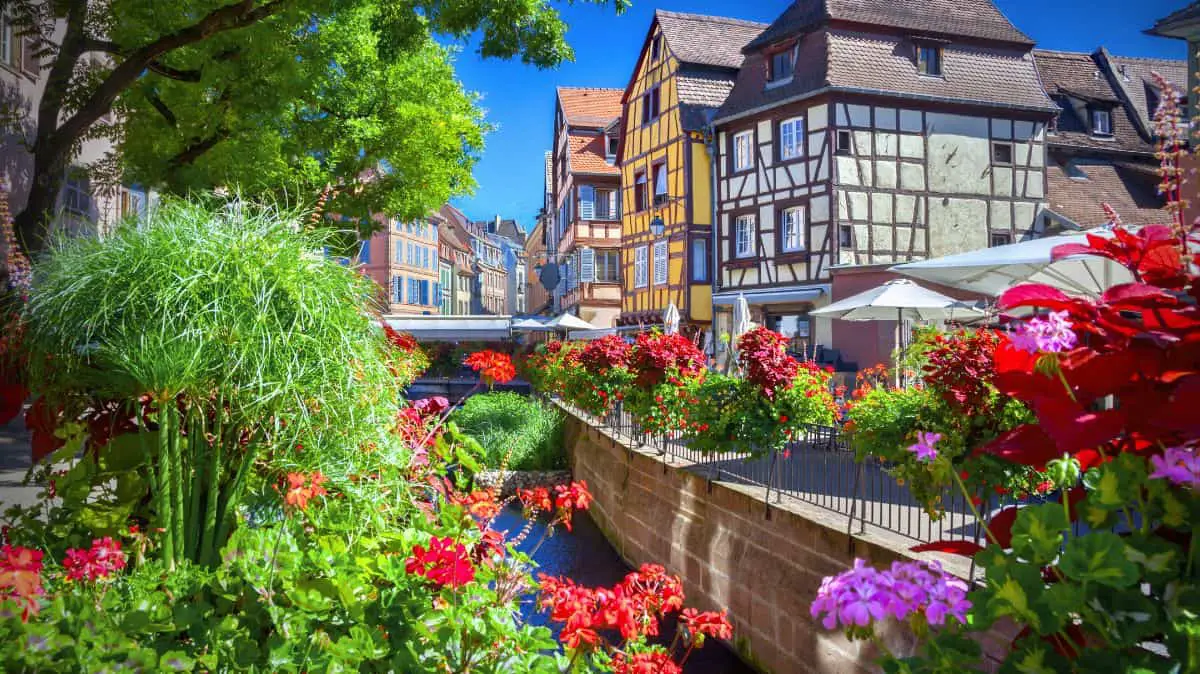
If you’re not sure what exactly a descriptive essay is and how to write one, you’ve come to the right place. I’m Tutor Phil, and in this tutorial I’ll explain how a descriptive essay works and how to write it, step by step.
We’ll write one together, so you’ll have a great example of a descriptive essay.
What Is a Descriptive Essay?
A descriptive essay is a piece of writing in which the author describes a place, a person, an object, an animal, or a process. The purpose of a descriptive essay is to move the reader to some kind of a revelation, conclusion, or decision about the subject.
It is very important to note that a descriptive essay is not an argumentative essay. You’re not presenting an argument and doing whatever it takes to support it.
In a descriptive essay, your intention should be to describe the subject in such a way that the reader would create her own impression of it.
At the same time, your essay is not neutral because it is colored by your own perception or experience of the subject.
In other words, you are implying and suggesting, not blatantly pushing an opinion.
You want to let the reader see, hear, touch, smell, and taste the place you’re describing. And that experience should lead the reader to an appropriate impression or conclusion.
Writing a Descriptive Essay Is a 6-Step Process
Step 1. choose the subject.
Maybe your instructor has already chosen the subject for you. If not, choose a country, city, or a place within a city or a geographical location that you are familiar with.
Ideally, it is a place that you have been to and have a good memory of it. A descriptive essay about a place should not rely solely on research, in most cases.
The real value of your essay is that you know that place, and perhaps it has a special meaning for you or evokes feelings that no other place can evoke.
So, unless you have to write about a specific place where you have never been, choose a location that has a special place in your heart.
Sometimes, your subject can be a place with which you may have negative associations. But most likely, it is a beloved place that has left an indelible impression on your heart and mind.
Criteria for choosing the place
- Ideally, this place should be dear to your heart
- It is unique. It is unlike any other place you’ve ever been to, in at least one or two important ways
- It has left a strong impression on you
- Perhaps you learned something there
- Perhaps something wonderful happened to you there, such as meeting your soulmate or discovering something about yourself
- Ideally, it has special visual qualities that stand out in contrast to what your audience is probably used to. In other words, being visually striking is a huge plus.
I’ll give you an example. For me, one particular little spa town in Europe won me over when I first visited it many years ago. Its name is Carlsbad, or Karlovy Vary. The terms are interchangeable. One is of German origin, and the other is native Czech.
It is located in the western part of Czech Republic, not too far from the German border. It is serene, spectacular, and magical, and I’ll choose it as the subject for our sample descriptive essay.
By the way, Carlsbad, California was named after Karlovy Vary because of the similar mineral content of the underground waters found in the American cousin city.
Step 2. Pick an audience
I understand that you’re probably writing this essay to fulfill a requirement for your class. In which case, your audience is your teacher or professor.
But even if you’re writing for your instructor, you should still have a particular audience in mind because this will help you form ideas and keep your thoughts flowing.
Knowing your audience will inform your choices of what to include and what to exclude in your descriptive essay because your reader may care about some aspects of this place but not others.
Criteria for choosing an audience
- Your ideal reader is someone who is most likely to be interested in this place
- It is someone who is likely to enjoy reading your essay
- Your ideal audience is also someone who will benefit from reading about this place and derive the most value from it
Let’s come back to our example of Karlovy Vary. As I already mentioned, it is a spa town, which means that its attractiveness lies in its therapeutic qualities.
I first visited this gem of a town back in 2004 as a result of a real academic and professional burnout. I believe I was still an undergraduate student finishing up my studies, and I also had a stressful job.
I lived in Brooklyn, which is a borough of New York City, and this metropolis is known for its stressful lifestyle.
New York has all the disadvantages of living in a large city, such as pollution and other stressors that can really suck the life energy out of its dwellers if they are not careful.
I lived in New York for 25 years, and I love this city. I don’t want to come across as totally negative about it.
But focusing on the negatives about my city in this case will help you see how I am choosing the audience for this essay we’ll be writing together in this tutorial.
You see, New York City is a direct opposite of Karlovy Vary in several critical ways.
Establishing a contrast helps define an audience
New York is noisy. Drivers here are notorious for incessant horn honking. And you can hear an ambulance or a police siren probably every 15 minutes or so.
Conversely, Karlovy Vary is super quiet. Such a crazy hustle and bustle doesn’t exist here, and drivers don’t have a reason to honk the horn all the time. It is also very rare to hear a police or an ambulance siren.
Air quality in New York is decent for a big city, but it is still relatively polluted . All the millions of cars and trucks produce way too much carbon dioxide. You can actually see the smog from some vantage points.
The air in Karlovy Vary is virtually pristine. The town is surrounded by hills, and car traffic is not allowed in the city center.
The landscape in New York is a bit monotonous and often fails to inspire. They don’t call this city “a concrete jungle” for nothing. The overall atmosphere is hardly conducive to a great mood or daily inspiration.
Conversely, Karlovy Vary offers aesthetically pleasing, relaxing, and inspiring architecture and landscape. It’s like entering a spa, only the spa is a whole town.
Now that we have this contrast, it is easy to see who might be interested in learning more about Karlovy Vary. Our ideal audience is someone who:
- Lives in a big metropolis, such as NYC or another big city
- Can relate to being excessively stressed out
- Is aware of noise and air pollution
- Would love an escape to relax and renew, even if only by reading an essay.
So, our essay becomes a sort of a virtual or a fantasy escape until an actual trip becomes possible.
Your audience might have different challenges, needs, and desires. It could be someone who:
- Is nostalgic about their childhood and a place associated with it
- Dreams about a perfect place to live and work
- Plans a retirement location
Think of these factors when determining your audience. In the meantime, because we’ve already identified our ideal reader – a stressed out urban dweller – we can move on to the next step.
Step 3. Divide the subject into subtopics
No matter what kind of an essay you’re writing, you want to divide the main topic into subtopics. In other words, you want to create some kind of a structure that will consist of parts.
I use and teach my students to use the technique I call the Power of Three.

What this means is that instead of having just one big topic, such as one town, we can have three aspects of this town to discuss.
Incidentally, we already talked about three major differences between NYC and Karlovy Vary. These are noise levels, air quality, and landscape. So, perhaps we can use one or more of these aspects of a city as sections of our essay.
We must keep in mind that we’re not writing a comparative essay , although that’s a possibility, too.
We’re writing a descriptive essay. So, we need to find three aspects of the town that we can discuss one after another to put together a rich and detailed enough picture of this place.
Note that these three aspects correspond to the senses of hearing, smell, and sight.
Let’s make a preliminary list of such aspects of Karlovy Vary:
- Quietness. Does this aspect present an interesting description opportunity? This will depend on our ability to turn it into an asset.
- Air quality. This may be too specific. We may want to zoom out a little and discuss more than one natural asset of this city. Some of the others include water quality and the industries associated with it.
- Landscape. This is the most conspicuous aspect of this city. The first thing you’re struck with is how beautiful this place really is. This one is definitely a winner.
If we go about writing about these three aspects of Karlovy Vary creatively, we will have three nice sections or paragraphs that will form the body of our essay.
Note that we’ll probably use more than one sensory perception, such as sight or smell, in each section. We’ll simply use one of three senses as a primary focus in each of our three sections.
It would make sense to begin the discussion of the city by describing it visually. So, this will be our primary focus in the first section.
Then, we can proceed to the sense of hearing. Why? Because our last section will be about air and water. And we should probably leave those for last because we can hear the water before we can taste it. That’s just the way it works in Karlovy Vary.
So, the primary sense perception in our second section will be hearing. And this section won’t be just about how quiet it is.
In fact, the real contrast between a big city and Karlovy Vary is the quality of the soundscape, not just the simple quietness, although it’s a part of it. So, we’ll focus on all the little sounds that make this place unique.
Finally, in the third section or paragraph, we’ll talk about the air and the water, which will correspond to the senses of smell and taste, primarily.
Again, we’ll be using any sense perceptions we feel necessary to make the reader’s experience as real as possible.
And now we have our place, we know our audience, and we have our three main ideas about this place that we’ll use to structure the essay.
We can begin writing, and we’ll start with the opening paragraph.
Step 4. Write the introduction
An introductory paragraph in a descriptive essay offers you a lot of flexibility in how you choose to write it.
You can start off with a particular example of a sense perception, drop your reader in the middle of a town square, or begin with an abstract concept.
I would like to suggest an easy and practical way to do it. In the first sentence or two, pull your reader from the outside world into this particular magical place you’ve chosen to write about.
Then, focus on the place you want to describe and say something general about it that would set the context or provide a perspective.
And finally, set some kind of an expectation for what’s to follow. You can create a sense of mystery, if you like. Remember, this is not an argumentative essay. So, you have more room for creativity.
This is where we begin to put together our descriptive essay example. Let’s write our introductory paragraph.
Descriptive Essay Introduction
“When the city has worn you down, the body is tired, and the soul yearns for a respite, you can count on a little magic gem of a town that will nourish you back to life. The name of the place is Karlovy Vary, and it is nested in the heart of Europe, in Western Bohemia, a region in Czech Republic famous for its spa towns. Its beautiful architecture, therapeutic landscape, clean air, and mineral waters offer the weary a healing adventure and a feast for the senses.”
What have we done in this paragraph?
We’ve pulled the reader into the world of this small spa town. We first descended in their world of the stressful city, and then we turned their attention to its opposite. We named the town and explained where it is located.
And finally, we provided a glimpse of what to expect in this descriptive essay about this town. Now, we’re ready to write the body of the essay.
Step 5. Write the body of the essay
We know our three main sections, which in this case correspond to three sense perceptions. Each section can have more than one paragraph. It all depends on how long your essay has to be.
If you are writing an essay of about 500-600 words, then a five-paragraph structure will do the job. If you need to write 2000 words or more, then you’ll have three sections instead of just three paragraphs.
And then each section can also be divided into two or three subsections (using the Power of Three, if you like). And each subsection can be a paragraph or more.
Just remember – the more words you need, the more dividing into subtopics you must do. The key to writing more is dividing one idea into several supporting ideas. And then you simply treat each supporting idea as a tiny essay.
If you struggle with essay writing in general or need to brush it up, I recommend you read my tutorial on essay writing for beginners . This would be a great place to turn to next.
Now, let’s write out our body paragraphs. Since there’s quite a bit to cover, we’ll probably take two paragraphs per section to get the job done.
Descriptive essay body paragraphs
“When you stay in one of the pretty little hotels in Karlovy Vary, you are likely to be descending the hills towards the hot springs every morning. No matter which part of town you live in, you’ll be greeted with a magnificent sight of little hotels and spas whose architecture has a unifying 19th century style. At the same time, each building has its own character, color, and features. The town is situated on several hills, and the hotels are lined up along about four levels.
The first level is down by the river Tepla, and these hotels are only a few because most of the downtown is occupied with hot springs colonnades where people gather and drink hot mineral water. The next three levels ascend from the springs, and you can either take the stairs or even use a funicular that will take you to the highest level to the Hotel Imperial. As you exit your hotel in the morning, you are greeted with a sight of a collection of small, three to four story buildings that look like birthday cakes. They are pink, green, blue, red, turquoise, and any color you can imagine. You suddenly realize how this variety of colors and shapes strewn over the hillsides all facing you and the city center makes your head spin and makes you feel like you’ve never felt before. Your healing has begun with landscape therapy.
As you descend the stairs to reach the hot springs, you notice the abundance of oxygen in the air because it has a subtle but distinct smell, a bit like the way air smells right before a rain. Then, as you pass by another hotel, and you’ll pass more than one, a light whiff of toast and fried eggs with bacon hits you, stirring your appetite. It is customary to drink a cup of hot mineral water before you come back to your hotel for breakfast. It is called a drinking cure.
As you keep walking towards the geyser and the springs that surround it, you notice another astonishing detail. Nobody is in a rush. Nobody has anywhere to be except right here, right now. Travelers with cute little porcelain cups stroll along without a worry in the world, taking in the sights, the smells, and the sounds of the birds chirping and singing all around. Their serenity infects you. You slow down, too. You begin to look, smell, and listen. This town has got you.
Karlovy Vary is famous for its healing mineral waters that are known to alleviate gastrointestinal issues. These waters really do have magic powers. You have your little sipping cup with you, and when you reach one of the springs, you wait for your turn to fill it up, walk off, and begin sipping. The water has a very subtle smell, but its taste is pretty strong for water. It has very high mineral content and tastes salty. Most people like the taste. Some find it too strong. But one thing is for sure – by the time you’re about half way through with your cup’s content, your digestive juices have begun to stir.
The hot springs flow out through several fountains, each with its own intricately detailed colonnade. The mineral content of water bursting out of each fountain is identical. But the temperature of the water varies from really hot to mild and comfortable. Your “spa doctor” actually prescribes which fountains to use and how much to drink. Sipping the water out of a special porcelain cup with a built-in straw-like system is a special pleasure of its own. The point is not to rush but to take about 20 minutes to empty the cup. In the meantime, you have a chance to take in the magnificent serenity that surrounds and infuses you. When you’ve drunk your water, it is time to head back to your hotel and eat breakfast. You repeat this routine three times a day for the duration of your stay. By day three, you are serenity itself. By day fourteen, you are a brand new person.”
Step 6. Write the conclusion
A conclusion in a descriptive essay is, like the introduction, more flexible than a conclusion in an argumentative essay.
You can conclude your essay in any way you really want as long as you observe one rule. Just make sure you zoom out and write in more general terms.
It is not the time to add specific details and examples. This is the time to wrap things up and end on a general note.
Your conclusion can be very short – only a couple of sentences. But you can take your space and write as much or as little as you feel like. You can always go back and trim it down or beef it up.
Let’s write our conclusion.
Our Conclusion
“Upon reading this, you may feel that this town is described as some sort of a paradise. And in a way, it is, especially if you are traveling from a big city and carrying a load of accumulated stress. But it’s not until you see, touch, smell, hear, and taste it for yourself that this European jewel will become a part of your entire being forever.”
It’s okay to be a little emotional and perhaps to even exaggerate a little in the concluding paragraph. Just notice that this one is more general than any of the body paragraphs.
It also touches upon or mentions every sense perception evoked in the body of the essay.
Your Key Takeaways
- A descriptive essay is much more flexible and has a lot fewer rules than an argumentative essay.
- Use the five sense perceptions – sight, smell, touch, taste, and hearing – to structure your essay.
- You don’t have to organize your essay by sense perceptions. You can divide your place into sections and walk the reader through each one.
- You can even structure your essay as a string of paragraphs that describe one particular walk or route, from beginning to end.
- Our last body paragraph is a description of the process of drinking hot mineral water in Karlovy Vary. It is a perfect example of a description of a process, if you ever want to write that kind of an essay.
- Don’t persuade but subtly suggest.
- Show, don’t tell, whenever you can.
A Few Scenic Snapshots of Karlovy Vary’s Charm
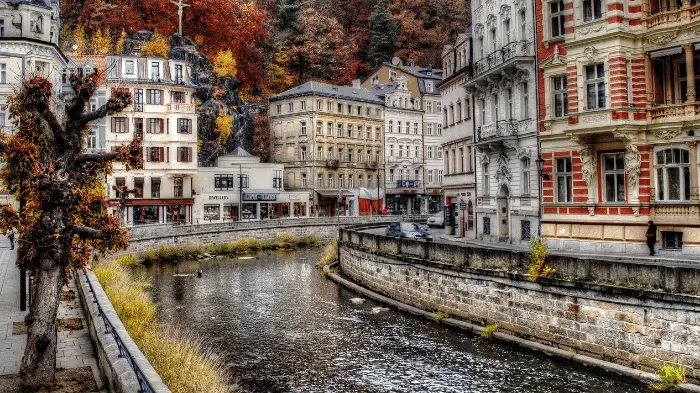
I hope this was helpful. Now go ahead and write that descriptive essay about a place!
Tutor Phil is an e-learning professional who helps adult learners finish their degrees by teaching them academic writing skills.
Recent Posts
How to Write an Essay about Why You Want to Become a Nurse
If you're eager to write an essay about why you want to become a nurse, then you've arrived at the right tutorial! An essay about why you want to enter the nursing profession can help to...
How to Write an Essay about Why You Deserve a Job
If you're preparing for a job application or interview, knowing how to express why you deserve a role is essential. This tutorial will guide you in crafting an effective essay to convey this...
Writing About Cities
- Writing Skills
- Pronunciation & Conversation
- Reading Comprehension
- Business English
- Resources for Teachers
- TESOL Diploma, Trinity College London
- M.A., Music Performance, Cologne University of Music
- B.A., Vocal Performance, Eastman School of Music
Read the following paragraphs introducing Portland, Oregon. Notice that each paragraph focuses on a different aspect of the city.
Portland, Oregon is located in the northwest of the United States. Both the Columbia and the Willamette river run through Portland. It is the largest city in the state of Oregon. The city is famous for its proximity to the mountains and the ocean, as well as its relaxed, friendly inhabitants. Approximately 500,000 people live in Portland while the Portland metro area has a population of over 1.5 million inhabitants.
The main industries in the Portland area include computer chip manufacturing and sportswear design. In fact, two famous sportswear companies are based in the Portland Area: Nike and Columbia Sportswear. The largest employer is Intel which employs over 15,000 people in the greater Portland metro area. There are also many smaller technology companies located in downtown Portland.
Portland's weather is famous for its rain. However, the spring and summer are quite lovely and mild. The Willamette V alley to the south of Portland is important for its agriculture and wine production. The Cascade Mountains are located to the east of Portland. Mt. Hood has three major skiing facilities and attracts hundreds of thousands of visitors each year. The Columbia river gorge is also located close to Portland.
Tips for Writing an Introduction to a City
- Discuss one aspect of the city in each paragraph. For example, one paragraph about general facts and population, one paragraph about industries, one paragraph about culture, etc.
- Use resources such as Wikipedia to help you find facts about the city.
- Use 'its' as a possessive when writing about a city (not her, or his). For example, Its main exports are ...
- When using numbers, write out the numbers up to twenty. For larger numbers, use numerals. For example: There are two professional sports organizations ... BUT There are over 130,000 inhabitants in XYZ.
- Use 'million' when expressing very large numbers. For example, 2.4 million people live in the greater metro area.
- Make sure to capitalize specific names of companies and monuments.
- Use both the comparative and superlative forms to make statements relating to other cities and regions. For example: It is the largest producer of apples in the state.
Helpful Language
X is located in the Y region of (country) X lies between the A and the B (mountains, valleys, rivers, etc.) Located at the foot of the B mountains Located in the R valley
X has a population of Z More than (number) people live in X Approximately (number) people live in X With a population of (number), X .... inhabitants
X is famous for ... X is known as ... X features ... (product, food, etc.) is important for X, ...
The main industries in X are ... X has a number of Y plants (factories, etc.) The main employers of X are ... The largest employer is ...
Writing About a City Exercise
- Choose a city you would like to describe.
- Find a research page for reference purposes. You can use sites like Wikipedia, magazines, or other resources.
- Choose three or four broad topics you would like to discuss.
- For each topic, write down a list of specific facts using your reference materials. For example: Weather - more than 80 inches of snow on average extremely hot summers etc.
- Take each fact and write a sentence about that fact. For example: Boulder receives more than 80 inches of snow on average each winter.
- Combine your sentences into a paragraph on each broad topic. Make sure to use linking language , pronouns, etc. to link the ideas in your sentences into a logical sequence.
- If you are using a computer, make sure to spell check your work.
- Personal Descriptions
- How To Write an Essay
- Teaching Writing to Beginning ESL Students
- 3 Tips to Improve Writing in English
- Writing Descriptive Paragraphs
- Writing Cause and Effect Essays for English Learners
- Structure of a Formal Letter
- Buildings and Places: Key Vocabulary in English
- How to Write a Great Essay for the TOEFL or TOEIC
- Persuasive Writing: For and Against
- English Vocabulary and Examples for Talking About the Weather
- How to Write a Resume for Non-Native English Speakers
- Teaching Telephone English
- How to Teach the Present Continuous to ESL Students
- Paragraph Writing
- Integrating Target Structure
Have a language expert improve your writing
Run a free plagiarism check in 10 minutes, generate accurate citations for free.
- Knowledge Base
- How to write a descriptive essay | Example & tips
How to Write a Descriptive Essay | Example & Tips
Published on July 30, 2020 by Jack Caulfield . Revised on August 14, 2023.
A descriptive essay gives a vivid, detailed description of something—generally a place or object, but possibly something more abstract like an emotion. This type of essay , like the narrative essay , is more creative than most academic writing .
Instantly correct all language mistakes in your text
Upload your document to correct all your mistakes in minutes

Table of contents
Descriptive essay topics, tips for writing descriptively, descriptive essay example, other interesting articles, frequently asked questions about descriptive essays.
When you are assigned a descriptive essay, you’ll normally be given a specific prompt or choice of prompts. They will often ask you to describe something from your own experience.
- Describe a place you love to spend time in.
- Describe an object that has sentimental value for you.
You might also be asked to describe something outside your own experience, in which case you’ll have to use your imagination.
- Describe the experience of a soldier in the trenches of World War I.
- Describe what it might be like to live on another planet.
Sometimes you’ll be asked to describe something more abstract, like an emotion.
If you’re not given a specific prompt, try to think of something you feel confident describing in detail. Think of objects and places you know well, that provoke specific feelings or sensations, and that you can describe in an interesting way.
Receive feedback on language, structure, and formatting
Professional editors proofread and edit your paper by focusing on:
- Academic style
- Vague sentences
- Style consistency
See an example

The key to writing an effective descriptive essay is to find ways of bringing your subject to life for the reader. You’re not limited to providing a literal description as you would be in more formal essay types.
Make use of figurative language, sensory details, and strong word choices to create a memorable description.
Use figurative language
Figurative language consists of devices like metaphor and simile that use words in non-literal ways to create a memorable effect. This is essential in a descriptive essay; it’s what gives your writing its creative edge and makes your description unique.
Take the following description of a park.
This tells us something about the place, but it’s a bit too literal and not likely to be memorable.
If we want to make the description more likely to stick in the reader’s mind, we can use some figurative language.
Here we have used a simile to compare the park to a face and the trees to facial hair. This is memorable because it’s not what the reader expects; it makes them look at the park from a different angle.
You don’t have to fill every sentence with figurative language, but using these devices in an original way at various points throughout your essay will keep the reader engaged and convey your unique perspective on your subject.
Use your senses
Another key aspect of descriptive writing is the use of sensory details. This means referring not only to what something looks like, but also to smell, sound, touch, and taste.
Obviously not all senses will apply to every subject, but it’s always a good idea to explore what’s interesting about your subject beyond just what it looks like.
Even when your subject is more abstract, you might find a way to incorporate the senses more metaphorically, as in this descriptive essay about fear.
Choose the right words
Writing descriptively involves choosing your words carefully. The use of effective adjectives is important, but so is your choice of adverbs , verbs , and even nouns.
It’s easy to end up using clichéd phrases—“cold as ice,” “free as a bird”—but try to reflect further and make more precise, original word choices. Clichés provide conventional ways of describing things, but they don’t tell the reader anything about your unique perspective on what you’re describing.
Try looking over your sentences to find places where a different word would convey your impression more precisely or vividly. Using a thesaurus can help you find alternative word choices.
- My cat runs across the garden quickly and jumps onto the fence to watch it from above.
- My cat crosses the garden nimbly and leaps onto the fence to survey it from above.
However, exercise care in your choices; don’t just look for the most impressive-looking synonym you can find for every word. Overuse of a thesaurus can result in ridiculous sentences like this one:
- My feline perambulates the allotment proficiently and capers atop the palisade to regard it from aloft.
An example of a short descriptive essay, written in response to the prompt “Describe a place you love to spend time in,” is shown below.
Hover over different parts of the text to see how a descriptive essay works.
On Sunday afternoons I like to spend my time in the garden behind my house. The garden is narrow but long, a corridor of green extending from the back of the house, and I sit on a lawn chair at the far end to read and relax. I am in my small peaceful paradise: the shade of the tree, the feel of the grass on my feet, the gentle activity of the fish in the pond beside me.
My cat crosses the garden nimbly and leaps onto the fence to survey it from above. From his perch he can watch over his little kingdom and keep an eye on the neighbours. He does this until the barking of next door’s dog scares him from his post and he bolts for the cat flap to govern from the safety of the kitchen.
With that, I am left alone with the fish, whose whole world is the pond by my feet. The fish explore the pond every day as if for the first time, prodding and inspecting every stone. I sometimes feel the same about sitting here in the garden; I know the place better than anyone, but whenever I return I still feel compelled to pay attention to all its details and novelties—a new bird perched in the tree, the growth of the grass, and the movement of the insects it shelters…
Sitting out in the garden, I feel serene. I feel at home. And yet I always feel there is more to discover. The bounds of my garden may be small, but there is a whole world contained within it, and it is one I will never get tired of inhabiting.
If you want to know more about AI tools , college essays , or fallacies make sure to check out some of our other articles with explanations and examples or go directly to our tools!
- Ad hominem fallacy
- Post hoc fallacy
- Appeal to authority fallacy
- False cause fallacy
- Sunk cost fallacy
College essays
- Choosing Essay Topic
- Write a College Essay
- Write a Diversity Essay
- College Essay Format & Structure
- Comparing and Contrasting in an Essay
(AI) Tools
- Grammar Checker
- Paraphrasing Tool
- Text Summarizer
- AI Detector
- Plagiarism Checker
- Citation Generator
Here's why students love Scribbr's proofreading services
Discover proofreading & editing
The key difference is that a narrative essay is designed to tell a complete story, while a descriptive essay is meant to convey an intense description of a particular place, object, or concept.
Narrative and descriptive essays both allow you to write more personally and creatively than other kinds of essays , and similar writing skills can apply to both.
If you’re not given a specific prompt for your descriptive essay , think about places and objects you know well, that you can think of interesting ways to describe, or that have strong personal significance for you.
The best kind of object for a descriptive essay is one specific enough that you can describe its particular features in detail—don’t choose something too vague or general.
Cite this Scribbr article
If you want to cite this source, you can copy and paste the citation or click the “Cite this Scribbr article” button to automatically add the citation to our free Citation Generator.
Caulfield, J. (2023, August 14). How to Write a Descriptive Essay | Example & Tips. Scribbr. Retrieved March 31, 2024, from https://www.scribbr.com/academic-essay/descriptive-essay/
Is this article helpful?

Jack Caulfield
Other students also liked, how to write a narrative essay | example & tips, how to write a literary analysis essay | a step-by-step guide, how to write an expository essay, unlimited academic ai-proofreading.
✔ Document error-free in 5minutes ✔ Unlimited document corrections ✔ Specialized in correcting academic texts
City Life Essay
500+ words essay on city life.
City life is very busy, fast-moving and restless. All the necessary things are easily available in the city. Life is full of luxuries, and everything is within reach. The city has many things to offer, such as better job opportunities, higher living standards, medical facilities, clubs, shopping malls, stores, restaurants, etc. It has theatres, amusement parks, cricket stadiums etc., for entertainment. People from rural areas are shifting to the cities for a better quality of life. This essay on city life will throw light on the positive and negative aspects of city life. Students must go through it and try to write their own essays. For more practice, they can go through the list of different essay topics, which will help in improving their writing section.
Positive Aspects of City Life
Life in a big city is a whirl of activities. Very often, people from the countryside move to the cities in order to find decent jobs. It offers good educational facilities for children by providing the best schools, colleges and institutions. Cities have always been the hub of innovation, the home of creative thought, art forms, political ideas and many more things. People of the city do not waste their time as they keep doing something to gain growth and success in their life. Cities are well connected with road, railway and flight networks. So, it becomes easy for individuals to connect with other people and grow their businesses as compared to rural areas. Cities have become a potent force for addressing economic growth, development and prosperity.
Negative Aspects of City Life
Cities are very crowded places. The cost of living in the city is high. The houses are small and inadequate due to space limitations. Bad housing conditions can cause various health issues. The environment of the city is very polluted due to the air, water, land and noise pollution. This causes bad health and can infect people with various diseases.
Some of the cities are very dirty due to the lack of a proper disposal system. Also, drainage problems are often found in the city. People do not get fresh air to breathe and natural places where they can rejuvenate themselves. People in the city are often busy, so they do not socially interact with others. They limit themselves to their houses and families. Sometimes, they don’t even know about their neighbours and surroundings.
The impact of the city on a person’s life is both negative and positive. From the bad quality of air to noise pollution and restless life, it has affected peace of mind. But cities are also stimulating as centres of industry, art, science and political power. They are the focus of progress. By reducing the aggressive impact of the city on people, the essential positive aspects of city life can be greatly intensified.
Students must have found this city life essay useful for improving their essay writing skills. They can get the study material and the latest updates on CBSE/ICSE/State Board/Competitive Exams at BYJU’S.
Leave a Comment Cancel reply
Your Mobile number and Email id will not be published. Required fields are marked *
Request OTP on Voice Call
Post My Comment
- Share Share
Register with BYJU'S & Download Free PDFs
Register with byju's & watch live videos.

Counselling
Essay On Bangalore
500 words essay on bangalore.
Bangalore is a city in the state of Karnataka. It is located at a higher altitude on the Deccan Plateau . It is very popular for a lot of things mainly its parks and gardens spread across the entire city. Through the essay on Bangalore, we will learn more about this beautiful city.

Introduction to Bangalore
Bangalore is home to various prestigious institutes, colleges and universities. In addition to this, it is also the hub of many software and aerospace industries. As the city offers many benefits, the population of the city is growing day by day.
Most importantly, the city is very clean and elegant despite the increasing industrialization. This city was renamed Bengaluru in 2014. If we consider the southern part of India, Bangalore stands to be the busiest city.
It is the industrial city of Karnataka because it is home to several IT organizations. Nonetheless, the major attraction of the city has to be the parks and gardens. Thus, it is also known as the garden city.
Moreover, the city’s growth rate is so impressive that it is the second most leading growing cities in India. Even though it is developing at a faster rate, it still manages to stay green, clean and free of pollution.
You can enjoy the tropical weather in this city. The three prominent seasons are monsoon, winter and summer. The main religion followed here is Hinduism followed by Islam and then Christianity, Jainism, Sikhism and more.
Get the huge list of more than 500 Essay Topics and Ideas
A Must Visit
Bangalore has a major language of Hindi, English, Marathi, Telugu, Tamil and more. Thus, people coming from anywhere won’t face a language barrier. Moreover, it is fun in the sense that it prefers underground music thereby being called the Rock Metal Capital.
Even though the city enjoys concerts, it also has a liking for classical music. The city celebrates most of the festivals like Holi, Diwali, Ganesh Chaturthi and more. It is also famous for its arts and crafts like ivory carving, doll making, Mysore painting, and wood carving.
Similarly, it also has earned a name for its beautiful quality local handicrafts, textiles, and more. When you visit Bangalore, don’t forget to visit the Lal Bagh Botanical Gardens, Ganesha Temple and Sultan’s Palace.
Moreover, the city is famous for the various lakes it has like Ulsoor Lake. In addition, other famous places to visit include the Jawaharlal Nehru Planetarium, National Parks, Cultural Centers, Nrityagam Village, and more.
Therefore, when you are visiting Bangalore, make sure to take a look around all the places mentioned above so that you can make the most out of your trip.
Conclusion of Essay on Bangalore
All in all, Bangalore is a beautiful city with the right balance of traditional and modern culture. Everyone must give this city a visit at least once in their life and see for themselves the excellence of the city bustling with youth and vigour.
FAQ of Essay on Bangalore
Question 1: What Bangalore is famous for?
Answer 1: Bangalore is famous for being the Silicon Valley of India. This capital city of Karnataka is a renowned IT hub and is home to some of the world’s major IT corporations which operate out of the city. Moreover, Bangalore is also the hub to many start-ups and Indian tech companies.
Question 2: Why is the Bangalore climate good?
Answer 2: Since Bangalore is at the centre of the peninsula and is not too far off from the coasts on both sides, it benefits from both the monsoons. The city stands at a height of about 900mts or 3000ft from sea level. As a result, the higher the altitude, the colder it tends to get.
Customize your course in 30 seconds
Which class are you in.

- Travelling Essay
- Picnic Essay
- Our Country Essay
- My Parents Essay
- Essay on Favourite Personality
- Essay on Memorable Day of My Life
- Essay on Knowledge is Power
- Essay on Gurpurab
- Essay on My Favourite Season
- Essay on Types of Sports
Leave a Reply Cancel reply
Your email address will not be published. Required fields are marked *
Download the App

Home — Essay Samples — Geography & Travel — City — A Stroll Through the City Streets
A Descriptive Narrative About a Street
- Categories: City
About this sample

Words: 1416 |
Published: Apr 11, 2019
Words: 1416 | Pages: 3 | 8 min read
Table of contents
Brigade road, church street, works cited.
- Chandran, R. (2019). Changing Urban Spaces and Cultural Practices in Bangalore. Routledge.
- Anand, R. (2014). Street Vendors and the Urban Informal Economy: Evidence from Bangalore, India. World Development, 62, 1-11.
- Singh, G. (2013). Bangalore: The Story of a City. Penguin UK.
- Nanjundappa, B. (2010). Bangalore: Growth of a Metropolis. Anmol Publications Pvt. Ltd.
- Tarimo, C. S. (2016). Street Vending in Bangalore: A Study of Livelihood, Space, and Informality. Journal of Asian and African Studies, 51(2), 230-245.
- Ghertner, A. D. (2015). Rule by Aesthetics: World-class City Making in Delhi. Oxford University Press.
- Sudhira, H. S., & Ramachandra, T. V. (2007). Bangalore-The Emerging City of India. Geography and You, 7(33), 68-72.
- Tarimo, C. S. (2017). Urban Governance and Street Vending in Bangalore: A Case of Public Space Contestation. Journal of Developing Societies, 33(3), 345-367.
- Sridhar, V. (2012). The Dead and the Dying: Health Care and Politic in Bangalore. Economic and Political Weekly, 47(23), 79-86.
- Ghertner, D. A. (2018). Rule by Aesthetics: World-class City Making in Delhi. In The Routledge Handbook of Urbanization in South Asia (pp. 266-278). Routledge.

Cite this Essay
Let us write you an essay from scratch
- 450+ experts on 30 subjects ready to help
- Custom essay delivered in as few as 3 hours
Get high-quality help

Dr. Karlyna PhD
Verified writer
- Expert in: Geography & Travel

+ 120 experts online
By clicking “Check Writers’ Offers”, you agree to our terms of service and privacy policy . We’ll occasionally send you promo and account related email
No need to pay just yet!
Related Essays
2 pages / 834 words
2 pages / 761 words
3 pages / 1165 words
2 pages / 1058 words
Remember! This is just a sample.
You can get your custom paper by one of our expert writers.
121 writers online
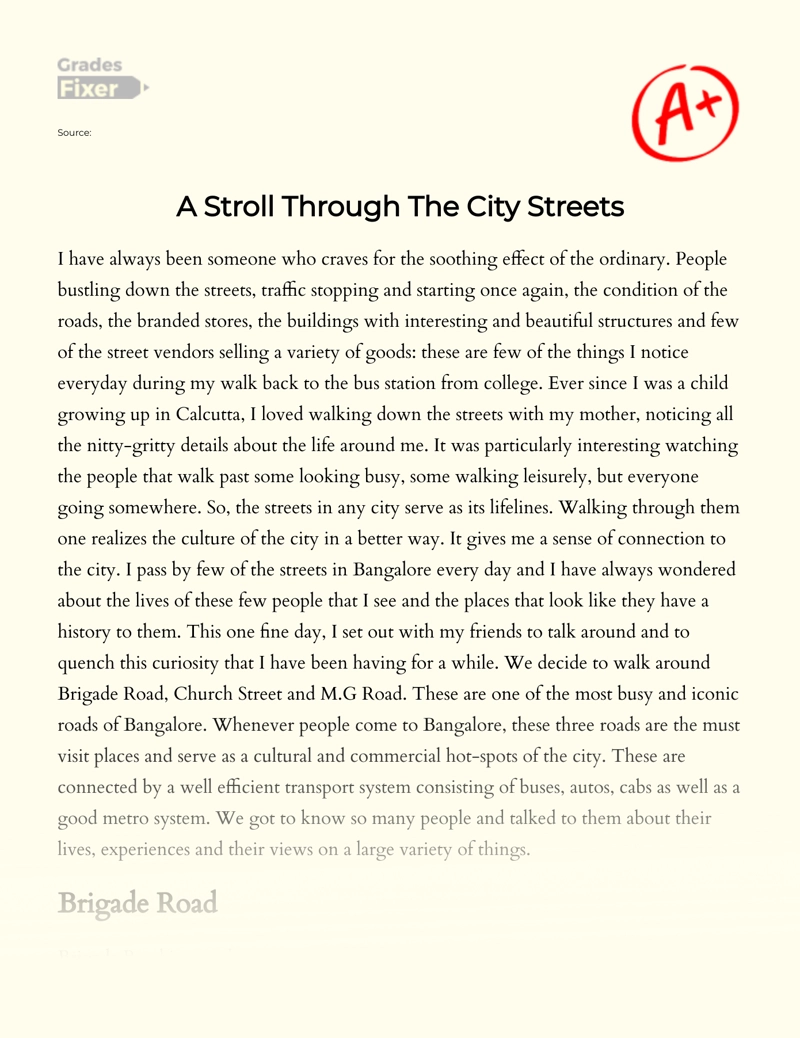
Still can’t find what you need?
Browse our vast selection of original essay samples, each expertly formatted and styled
Related Essays on City
The choice between living in a small town or a big city is a decision that many people face at some point in their lives. Each option offers a distinct set of advantages and disadvantages, catering to different lifestyles and [...]
The Renaissance, a period of cultural, artistic, and intellectual rebirth in Europe, saw the rise of Italian city-states as centers of innovation and progress. This essay will explore the political, economic, and social aspects [...]
Japan is the home to two very popular cities in the world; Tokyo and Kyoto. These two areas are major tourist destinations that attract explorers all over the world. As much as these towns have gained a lot of popularity, the [...]
In the annals of history, there are cities that rise to greatness, their names echoing through time. And then there are cities that are condemned to obscurity, their stories hidden in the shadows of the forgotten. This is the [...]
Paris is the capital city of France. With over 12 million inhabitants, it holds around 19% of France’s total population. Paris is most popularly known as the center of fashion. The city is also popular for its fine cuisine, art, [...]
The Nepalese government is preparing to build the so-called smart city in Kathmandu and other parts of the country. The authorities plan to make Kathmandu the first city in Nepal, ecologically and socially, economically smart. [...]
Related Topics
By clicking “Send”, you agree to our Terms of service and Privacy statement . We will occasionally send you account related emails.
Where do you want us to send this sample?
By clicking “Continue”, you agree to our terms of service and privacy policy.
Be careful. This essay is not unique
This essay was donated by a student and is likely to have been used and submitted before
Download this Sample
Free samples may contain mistakes and not unique parts
Sorry, we could not paraphrase this essay. Our professional writers can rewrite it and get you a unique paper.
Please check your inbox.
We can write you a custom essay that will follow your exact instructions and meet the deadlines. Let's fix your grades together!
Get Your Personalized Essay in 3 Hours or Less!
We use cookies to personalyze your web-site experience. By continuing we’ll assume you board with our cookie policy .
- Instructions Followed To The Letter
- Deadlines Met At Every Stage
- Unique And Plagiarism Free
- Skip to main content
- Skip to primary sidebar

Writing Tips Oasis - A website dedicated to helping writers to write and publish books.
How to Describe a Busy Street in Writing
By Isobel Coughlan

If you’re looking for guidance on how to describe a busy street, read on to learn about 10 words you can use to describe a bustling road.
Somewhere that’s very busy and contains rushed activity.
“Annie pushed down the hectic old street. She was surprised that such an aged avenue could still fit so many people.”
“As the sun rose, the street some became hectic . People rushed about completing their morning tasks as quickly as possible.”
How it Adds Description
“Hectic” shows that the street is busy because of rushed activity, such as people going to work or quickly running errands. This is a great way to set the scene in your books, as it paints a clear picture of the street’s atmosphere. Curious characters might be drawn to the “hectic” street, as they may enjoy people watching or simply being in the presence of others.
2. Overwhelming
Something that affects people very strongly.
“After five minutes on Oxford Street , Caroline was ready to leave. It was way too overwhelming for a peaceful stroll.”
“The mayor always avoided the main road. He found it a little overwhelming , especially in rush hour.
Sometimes busy streets leave people feeling “overwhelmed.” Therefore, you can use the adjective “overwhelming” to emphasize how busy the street is and that it’s too much for your characters. Typically, anxious, or stressed characters will be more affected by “overwhelming” or busy places. Some may even avoid busy streets completely because of their negative effect.
Somewhere full of people.
“He pushed his way through the crowded street, desperately trying to follow the man with the red hat.”
“Emily glanced at the crowded street and shuddered. There was no way she was going to fight through the mob of people.”
You can use the word “crowded” to illustrate a street is busy because it’s full of people. This means there’s little space left on the street, so characters might have a difficult time passing through it. This could leave them stuck in one place, which might make them feel stressed or anxious.
Something that looks expensive or grand .
“The opulent avenue impressed visitors from all over the world.”
“The woman strolled down the opulent street, admiring the ornate houses and bright colors as she walked.”
If your street features busy design and aesthetics, you could refer to it as “opulent.” This adjective describes a place that’s extremely luxurious with lots of riches to look at, perfect for a street that’s busy in terms of style — rather than people. Characters may flock to an “opulent” street for fun or inspiration, especially if they’re from a poorer neighborhood.
5. Bustling
Somewhere that’s full of activity or busy people.
“The bustling streets of New York were always a shock to tourists.”
“Tom followed the bustling streets all the way to the central train station. It wasn’t a peaceful journey, but there was a lot to see.”
You can show how many people are on your busy street by using the word “bustling.” This shows that your setting is difficult to navigate due to the sheer volume of people. It can also show your setting is a very populous area, and this can give your reader more context about the novel’s world.
6. Claustrophobic
Somewhere that leaves people feeling uncomfortable due to crowding or restriction.
“The young girl swallowed her discomfort and ducked and dived through the people on the claustrophobic street.”
“Adam felt the claustrophobic street closing in on him. He couldn’t handle the amount of people and the lack of space.”
“Claustrophobic” offers a negative portrayal of a busy street, as the adjective is linked to feeling uncomfortable or unhappy due to a crowded or restricted place. This emphasizes your character’s discomfort, and it shows the reader that they dislike busy places. Other characters may rush to help them, especially if they’re showing signs of physical stress due to the “claustrophobic” location.
7. Energetic
Somewhere or someone that has a lot of energy , physical movement, or power.
“The tall woman stood on the balcony and watched the energetic street below. It was captivating.”
“The energetic street hummed with the busy footsteps of civilians.”
You can use “energetic” to personify the street and imply that there are a lot of people there. Your characters might find an “energetic” street fascinating if they come from a small town, as they’re not likely used to seeing so many people in one place.
8. Dramatic
Somewhere that’s impressive or exciting .
“The dramatic street never slept. There was always something going on.”
“Sheila sulked on the side of the dramatic street, wishing she was part of the action.”
When a place is very busy and has lots of action, it can be described as “dramatic.” This shows that the action is more lively than usual. For example, there might be fights or grand displays of love. Eclectic characters might be drawn to this kind of setting as they love to be involved in or watch public spectacles.
Somewhere that feels extreme or severe.
“The street jostled with people, and there was barely space to move. It was an intense setting, but Taylor enjoyed the atmosphere.”
“As the New Year’s Day parade swooped through the street, the area became intense and hard to navigate.”
If a busy street isn’t pleasant or feels extreme, “intense” is an apt adjective. This shows that the setting might be shocking or overwhelming for characters, and this might make them try to escape or leave for some respite.
10. Popular
Somewhere liked or enjoyed by many people.
“The popular street attracted hordes of people, but no one cared about the crowds. They just wanted to bask in the street’s cool atmosphere.”
“Alice looked at the densely packed road. It was obviously popular with the youth of today.”
Not all busy places are negative or unpleasant, and you can show your street is busy yet positive via “popular.” This word shows that many characters wish to visit the place, perhaps due to its attractive design or cultural meaning. Some characters may even fixate on the “popular” street and its significance.

- TOP CATEGORIES
- AS and A Level
- University Degree
- International Baccalaureate
- Uncategorised
- 5 Star Essays
- Study Tools
- Study Guides
- Meet the Team
- English Language
- Writing to Inform, Explain and Describe
Creative Writing - Life in the City
Life In The City
The day in the city is starting: Claustrophobia. Frustration. Overcrowded. Crushing. Swarming. Cacophonous. Obstreperous. Clamorous. Vociferous.
The gloomy grey sky, with its heavy nimbostratus clouds, blocking all of the sun’s rays from reaching the Earth. The smoke from the industrial factories polluting the atmosphere and smelling like a failed chemical experiment. The fridge-like coldness of the winter air freezing your face.
Claustrophobia on the streets; commuters, shooting menacing glares at each other, attempt to rush to work. They fight their way past each other, determined to do anything they can to get to their destination. One businessman, dressed in a shirt and tie and clutching a black leather briefcase, is shoved back as the current of the swarm of people against him is too strong. The towering skyscrapers looking down at the strugglers in battle.

Across the road, the unpleasant cacophony of cars blaring their horns is heard above everything else. Frustrated drivers, already late for work, bellowing at the ever-changing traffic lights and wide lorries blocking half of the road. The overpowering skyscrapers watch over the events; their roofs almost brushing the heavens. Hectic life in the city goes on and on, and feels as though it will never end, that the commuters will never stop fighting their way into work, that the car drivers will never stop cursing at the traffic, that the city will never be empty…
This is a preview of the whole essay
…Night time in the city. Empty. Deserted. Silent. In the charcoal black sky, the effulgent crescent moon, the glistening stars forming illuminating constellations, the flickering lights of a plane that glides through a sky like a hawk.
Descending to the Earth, we observe the city in its now desolate state. Looking through a dimly lit, litter strewn alley, a homeless man crouches defensively, ready to go to sleep for the night. His scruffy, short, light brown hair covered with a worn out, chequered hat. His torn, tatty shirt and his trousers covered with holes both sizes too small for him. A few meters away, a rat scuttles over to the litter, scavenging around for food.
Turning into the car park, we see that the once overflowing place full of resting vehicles of every size and shape, now contains nothing but the dormant parking meter that patrols the area. Standing on one leg and lining up in a straight row like soldiers, the street lights provide the only source of illumination, their one eye emitting a golden beam of shining light down on the dusty, cracked pavement below.
Through the city park, the sea of trees is seen swaying gently in the whispering wind. Rippling reflections of the stars are shown in the peaceful pond. The vastest tree of the park comes into view with its narrow finger-like branches reaching skywards and brushing the heavens; its gnarled bark and broad trunk radiating infinite wisdom.
The silent, harmonious noises of the city now amplified. The ticking of the clock tower, the rustle of the autumn leaves being softly blown down the road by the wind, the high pitched creaking of the iron gates to the car park.
Soon the silent, tranquil city will be once again transformed into the blaring, claustrophobic city, and life in the city will start again.

Document Details
- Word Count 543
- Page Count 2
- Subject English
Related Essays

Creative writing

Creative writing - A New Life.

Creative Writing : Loser

Creative writing.
- Call us Topics in English
- Privacy Policy
- terms of use
Topics in English Topics in english to learn and fluent pronunciation and writing and facilitate conversation between you and others, whether in school, work or daily life
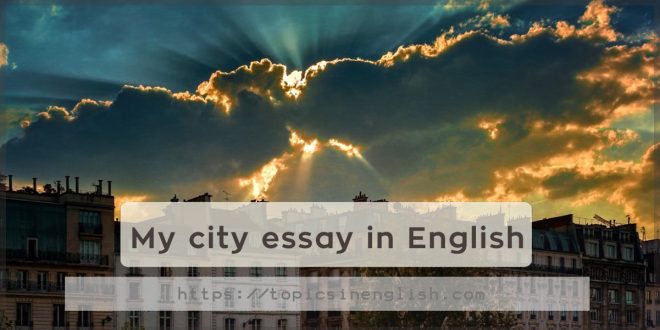
My city essay in English 15 models
Last updated Saturday , 16-03-2024 on 10:27 am
My city essay in English ,You will find many paragraphs in My city essay in English can install a short topic with the change of some of the names and places in your country to make this topic suitable for your country.
My city essay in English
The name of the city is (name of the city). Of the governorates (name of governorate) of (the name of the state). It is climate (type of climate) which makes it a beautiful city. it is (the distance) from the capital. It has a population of (population number) approx.
I live with my family consisting of my father, mother, younger brothers, grandparents, uncles, and their children.
My ancestors were born in this city; it is the home of my family since ancient times. My family works in the field of (work name), which is the work of most of the people of the city where I live.
I receive my education at the school (name of the school), one of the city schools. It was bult since a long time. My father, my mother and my uncles learned at this school.
My city has all the services. We have a market (market name) that provides the city with all its requirements of vegetables, fruits, meat, fish, poultry, grains, tools, fabrics and other products.
My town is famous for (what the city is famous for).
I like to wake up very early and walk the streets before people wake up and wait for the sunrise and the morning light that illuminates my city and inspires activity and hope.
My city’s residents are known for their diligence and hard workers. The city, which its people is characterized by these specifications, is clean and organized and developing rapidly to cope with global progress.
I love my city and I think it is the best place in the world. It is my homeland where I grew up and learned. In which My family, my friends live and work.
I visited many different cities, and whenever I visit a new city, I was looking for my city. I could not find a city like it.
I love my city and I plan to live there and I hope to be buried at my death next to my parents and grandparents.
I have planned my small project, which I will establish after graduation.
My project depends on my experience of my family’s work and the use of modern technology to develop it.
I love my city; it is a wonderful and developed city. I’m lucky to live in it.
My city essay
I love the city in which I live so much, My city is coastal and I live near the sea, I can see it whenever I go out for a walk or go to school.
This makes it a city that basically does not sleep, as there is always tourism that makes the city awake to cover the requirements of its arrivals.
This is what makes it always in constant development and improvement and a keen interest in the cleanliness of its streets and the construction of many modern buildings in it.
I really like to ride public transport. There is a bus that runs on the sea road only, and you can ride in the upper area and see all the sights in the city and see the beaches through it.
I can also sit in several ancient historical landmarks dating back to ancient times since the beginning of my town’s inception.
Essay on my city
I live in the (…..) city and I love it very much. My brothers and I grew up in this city and we know every area in it. We enjoy a lot watching football matches inside the (…..) stadium.
And every holiday we and all the family members go to a zoo and watch the animals and take some pictures, or enjoy sitting near the fish tank to see some of the new fish that have been included in the garden.
Then watch the main show and watch the dolphin playing with the coach and spraying water on the audience. It makes us interact a lot. I love my city very much because it has many restaurants, parks and beaches.
I enjoy a lot when we go out in the evening to eat in the famous (…..) restaurant. What I like about my city is that it is safe and we can go around and leave at any time and go back and walk on the roads without any fear.
I like very much to say hello to the police who are everywhere. Seeing them makes me feel safe.
I live in a coastal city, so I enjoy a nice mild weather all year round, and in the summer I spend most of my time on the beach, and my cousins come to visit us at the end of the year, and we go to the beach together, there are a lot of activities we do, such as playing football , or playing chess, in addition to swimming, I love my city very much, so I hope to live in it after I graduate from university, and I like to work in it also, I dream of being an engineer in the future, to design some beautiful beach houses.
My city topic
My city is the most beautiful city in the world from my point of view, because every person in this life sees that his city is the most beautiful because it is his homeland in which he was born. In my city, I lived with my family the most beautiful days of my life, as we used to meet during Ramadan and Eid. We have been celebrating the marriage of our relatives for long days. When I went to school, I got to know my friends and we used to have fun every day and play together.
I live in Luxor, which is known among all the cities of the world as a first-class tourist city, due to the presence of Pharaonic monuments and temples in it. Although it is a famous city and loved by people everywhere from all over the world, but I love it because it is my city and has my family, friends and beautiful memories.
My City Paragraph
I live in an industrial city with my family members. My father works in one of the factories near the house. My city is completely dependent on factories.
Factories represent the basic income of many families in my city. The factories in my town have a lot of large areas that help in accommodating a lot of workers.
I would very much like to become an engineer when I graduate because it is one of the most sought-after jobs in my city.
Many factories in the past closed due to lack of development, unlike many of the current factories, which are fiercely competitive and have a spirit of challenge.
I really like the competitive atmosphere that makes people give their best and this is what I want to participate in and experience.
Paragraph about my city
My name is (..). I am from the city of Geneva. I live in it with my family. I am (..) years old. I study in class (..). I love my city very much.
Geneva is famous for its beautiful scenery. It is also famous for its high quality watches. It is the best in this industry in the world.
I love spending time by the Geneva Fountain, which is a symbol of the city. The fountain was built in 1886. I also very much love spending time at the Museum of Contemporary Art for myself and my friends. This is the second special place we love to spend time at.
City Essay In English
Cities are famous for the large population congestion, and many high-rise buildings to accommodate the continuous housing increase, and the continuous expansion of transportation and communications, and the infrastructure must be strong to accommodate the huge number of people present in it.
The city is characterized by containing many profitable commercial opportunities, and provides various job opportunities. The city is also famous for having better education because it keeps pace with the modern era, and is more used, making it more developed.
There is no doubt that any city requires wealthy investors to pump projects and form trades that contribute to the national income of the state and the city, and whenever the appropriate climate is provided, the more investors flock to it.
Therefore, the city is considered one of the important and distinctive areas in which life is fast and profitable for many people.
My Beautiful City Essay
Undoubtedly, I love my city very much, and I love to roam and participate in many activities in it. I like to walk in the parks and do jogging daily.
I like very much to play sport in the garden ( write the name of the garden ). When I finished, I return home from a street of (type the name of the street). I can see the roses on this street and the trees on both sides, It makes me feel energetic, especially the scent of jasmine that is in the air.
After that, I like to go out to participate in some cultural activities that I share with my friends, such as going to the library or talking about some study matters that occupy us.
My city in the evening is beautiful, illuminated by large advertisements, and all the shops and commercial centers are open. We can go and walk around and shop or entertain ourselves.
I love the cinema very much and go to some famous movies like Kingdom of the Rings or something like that. I like to go out late with my family, have a meal at one of the restaurants near the house, enjoy talking with my mum and dad, and take a little drive around the road before going back to the house.
I never get tired of walking around the city and watching the streets. There is always something going on around us that we really enjoy watching it.
My city paragraph in English
My city is characterized by diversity and many differences that make it distinctive and unique, as there are several neighborhoods in my city and they are (write the names of the neighborhoods here). I live in the city of (type the name of the city). Inside a neighborhood of (type the neighborhood name here).
Nevertheless, each neighborhood in the city has its own unique character that retains its own identity, customs and traditions. Which makes there a great curiosity and desire to discover other areas and learn about other customs and traditions in the city.
My city is famous because of the hobby of (type the name of a hobby here). This hobby is shared by many city residents, and there are many playgrounds where we practice this sport.
In the evening, everyone loves to go out and wander the streets and sit on the sides of the roads in famous cafes and eat sweets or drinks.
Writing a paragraph about my city
I love my city very much. I live in a coastal city. In winter, the sea is empty, and walking on the sea promenade is wonderful and there is no crowding.
I like very much to ride my bike during sunset on the Corniche, me and my friends, and to roam some of the roads surrounding the neighborhood in which I live.
We go to play soccer on the beach many days, and we enjoy it a lot, especially since this opportunity does not come often.
Summer in my city, no one can move easily, many summer residents come to my city from neighboring countries that do not have beaches, and everything is crowded.
I also like this, as it represents a main source of income for the city, and all parents depend on it to provide as much as possible before the summer ends.
We own some apartments near the sea. In the summer, I like to help my father in advertising and bring in some tenants. This is profitable as the rent is for two or three days only, and the return is good. We rely heavily on these apartments in the summer.
When the day is over, I like to go with my friends to the cinema, take a walk in the parks, or go for meals in one of the famous restaurants.
It makes me happy, after working hard all morning I managed to make some money, and now I can enjoy it. I love my city so much for these reasons.
My city essay for class 2
I can say that I am one of the lucky people, as I was born in the city of (type the name of the city). It is a distinguished city where all services are available such as courts, stadiums, sports clubs, restaurants, the sea, parks, game and entertainment cities, zoo, hospitals, large police stations, ambulances, the best schools, the best universities.
So I am very happy to be here and live in it and I am very grateful that I was born in this city . I can say that I am fortunate in this, and I appreciate it and try to preserve it, by volunteering in many charitable activities, or keeping the city clean, and diligently studying, so that I can live in the city and enter the university.
I hope when I grow up I can present some projects or ideas that help in the development of the city and make it better than it is.
My city essay for class 10
My city is small and it doesn’t have a lot of amazing things like big cities. But we have love and security in my city, a quality that may not be present in big cities. I live in the city of (type the name of the city). In the region of (type the name of the region). I study in class 10.
Because of the small area of my city, everyone knows each other, and we gather on occasions on a regular basis, and on holidays we go out to the streets to celebrate.
We also have few schools in my city, so the children of the town are almost all in one place, so there is bonding and love between everyone, and all the way we greet each other. It makes me feel safe and I am in my safe zone.
I really like to ride my bike in the city and roam around the stadiums, and if the opportunity allows me to participate in some matches, I am very happy with that.
In addition to going to play some video games and others with my friends, and for a walk in the evening in the park with the family.
I find living in a small town wonderful and I don’t want anything else that we don’t have in our city. I am happy with it as it is and I hope to grow and participate in providing something useful for it.
My city essay in Eenglish for class 4
My city is very beautiful and I love spending time in it. I live in the city of (type the name of the city). I live in the neighborhood of (type the name of the neighborhood here).
I love the neighborhood in which I live at all times, whether it is morning or evening. There are always activities and games in the neighborhood that suit every time.
There are playgrounds for neighborhood children, and in the morning we play inside them. In the evening, the entire city is awake and full of activity and vitality, its streets are full of people, and everyone is wandering in the markets and shops.
I like to cycle with my friends in the streets, or go to the game centers, which are located in the big malls, and play a little.
This is how I see my city as beautiful and its streets are wide and clean, and the school is close to my home, and there is nothing difficult or dangerous in it.
Paragraph about your city
When you think about writing a paragraph about your city, you will always find yourself distracted and not knowing where to start writing. So we will shed some light on several good points that you can write about and use in writing your homework.
Undoubtedly, there are many wonderful areas in my city that make me fell happiness and pleasure, such as the picnic areas that contain large green areas, and which contain playgrounds and family entertainment areas, in which all family members meet.
I remember in my city the first time my father and mother took me to the park and took the bike with us to teach me driving. I remember my happiness a lot, and how my father worked hard with me to teach me to drive, and we spent the whole day trying to teach me to drive on my own. The presence of an area designated for cycling enthusiasts helped me a lot.
I also have several other areas where I have a lot of happy moments, such as cinemas, clubs that have a swimming pool. There I learned to swim with my coach.
My city is wonderful and has many wonderful places. We have wonderful and clean schools, and we own many famous and huge restaurants that I love to eat in , especially pizza.
We also have many wonderful malls that consist of more than one floor. I enjoy a lot of going with my family and wandering around all the floors and going up the escalator, and seeing the shops and clothes, that makes me very happy.
After touring and buying, we always go to eat ice cream or wonderful drinks in the cafe located at the bottom of the mall. We make this place a habit that we always repeat whenever we go to the mall.
This is my wonderful city that I love and I do not feel that there is anything missing.
In this way we have given you My city essay in English, and you can read more topics through the following section:
- English essay
Related Articles

Value of Time Essay 3 Models

Car accident essay 6 models

Essay on car 10 models
One comment.
Beautiful essay on my City.
Thanks for sharing.
Leave a Reply Cancel reply
Your email address will not be published. Required fields are marked *

IMAGES
VIDEO
COMMENTS
YouTube video by Crown Academy of English - How to describe a city in writing. 3 Full Examples of City Descriptions in Writing. Here are three full examples of how to describe a city in writing. Nonfiction Essay. Los Angeles is a sprawling city, spreading across a vast, flat coastal plain nestled between mountains and the Pacific Ocean.
Research the city. Determine the purpose of your description. Sensory Imagery. Personification. Breathing life into the city. Describing the city as if it were a character. How the city interacts with its inhabitants. Historical and Cultural Context. Character Reflection.
Visual Descriptions. When describing a city, it is essential to paint a vivid picture of what the reader can expect to see. The visual descriptions should be clear and concise, highlighting the unique features of the city. A wide and bustling city will have a lot of movement and activity, while a clean and vast city will have more open spaces.
Description of a city essay. I live in a big city, it includes a large number of factories, it is always crowded, you cannot go to work in time, in addition to the pollution of its air, so that many people suffer from serious diseases, such as chest and respiratory diseases, I advise that we expand In planting trees, as it helps to increase the ...
A descriptive essay is a type of writing that aims to describe and portray an object, person, or place. The essay typically includes sensory details to help the reader imagine its contents more vividly. Descriptive essays can be written about a person, place, or other themes like nature, autumn, food, or even yourself.
4. Green Cities. Beyond improving the environment and reducing pollution, green cities also promote better health and wellness for their citizens. List down your city government's efforts to shift toward a greener city. If you want to go the extra mile, interview city officials and city planners.
Step 4. Write the introduction. An introductory paragraph in a descriptive essay offers you a lot of flexibility in how you choose to write it. You can start off with a particular example of a sense perception, drop your reader in the middle of a town square, or begin with an abstract concept.
Discuss one aspect of the city in each paragraph. For example, one paragraph about general facts and population, one paragraph about industries, one paragraph about culture, etc. Use resources such as Wikipedia to help you find facts about the city. Use 'its' as a possessive when writing about a city (not her, or his).
Tips for writing descriptively. The key to writing an effective descriptive essay is to find ways of bringing your subject to life for the reader. You're not limited to providing a literal description as you would be in more formal essay types. Make use of figurative language, sensory details, and strong word choices to create a memorable ...
A descriptive essay is a type of essay that involves describing a person, object, or any type of noun. We guide you through writing one with examples. ... A country or city, broken down into geography, climate, politics, religion, and culture; A historical event, including its causes, ramifications, and consequences;
New York City, often referred to as the "Big Apple," is a place like no other. It is a melting pot of cultures, a hub of innovation, and a city that never sleeps. From the bustling streets of Times Square to the serene beauty of Central Park, there is something for everyone in this vibrant metropolis. In this essay, we will explore the sights ...
Descriptive Essay About My City. Our town is more home to us than our actual house. We make so much memories around town, whether it's dining out with the family at a local restaurant or learning how to ride a bike at our local park to spending our first paycheck at the local mall. Our town is very precious and we often take for granted, what ...
A word meaning 'relating to a large city' is metropolitan. (A metropolis is a very large city.) It ranks as one of the fastest-growing metropolitan areas in the US. A city that is described as sprawling covers a large area, usually in a rather untidy way, with various parts built at different times: Today, it's a sprawling metropolis of ...
A city could be engaging in the good side of a war effort, but it will take its toll on food, weapons, and the general morale of its people. Conversely, the leader of an evil city might love extravagance, so his city may be pristine and well-kept. This ties into the plot your book follows and which characters influence the city.
Descriptive Essay On A City. 736 Words3 Pages. If you ask someone to think of a city what comes to mind will likely be, long cloistered, grungy walkways, easily identifiable landmark buildings, and the marching on by of city folk with empty faces. Landmarks resonate with a city's identity, since city schemas are developed around these ...
Descriptive Essay About My City Our town is more home to us than our actual house. We make so much memories around town, whether it's dining out with the family at a local restaurant or learning how to ride a bike at our local park to spending our first paycheck at the local mall. Our town is very precious and we often take
500+ Words Essay on City Life. City life is very busy, fast-moving and restless. All the necessary things are easily available in the city. Life is full of luxuries, and everything is within reach. The city has many things to offer, such as better job opportunities, higher living standards, medical facilities, clubs, shopping malls, stores ...
500 Words Essay On Bangalore. Bangalore is a city in the state of Karnataka. It is located at a higher altitude on the Deccan Plateau. It is very popular for a lot of things mainly its parks and gardens spread across the entire city. Through the essay on Bangalore, we will learn more about this beautiful city. ...
Church Street. Church Street is one of the busiest streets in Bangalore. It connects Brigade Road and St. Mark's Road and runs parallel to M.G Road. It used to have broken pavements with a lot of potholes. Starbucks, Amoeba and Mast Kalandar are some of the flagship establishments prevalent there.
Descriptive Essay On The City. One weekend night I had the craving for some boneless wings and chili cheese fries. I don't drive and no one on campus could drive me so I decided to walk somewhere to get food. So, I put on my shoes and headed out of the dorms to satisfy my craving for chili cheese fries and buffalo wings.
How it Adds Description. You can use the word "crowded" to illustrate a street is busy because it's full of people. This means there's little space left on the street, so characters might have a difficult time passing through it. This could leave them stuck in one place, which might make them feel stressed or anxious. 4. Opulent Definition
Frustrated drivers, already late for work, bellowing at the ever-changing traffic lights and wide lorries blocking half of the road. The overpowering skyscrapers watch over the events; their roofs almost brushing the heavens. Hectic life in the city goes on and on, and feels as though it will never end, that the commuters will never stop ...
My city essay in English. The name of the city is (name of the city). Of the governorates (name of governorate) of (the name of the state). It is climate (type of climate) which makes it a beautiful city. it is (the distance) from the capital. It has a population of (population number) approx. I live with my family consisting of my father ...